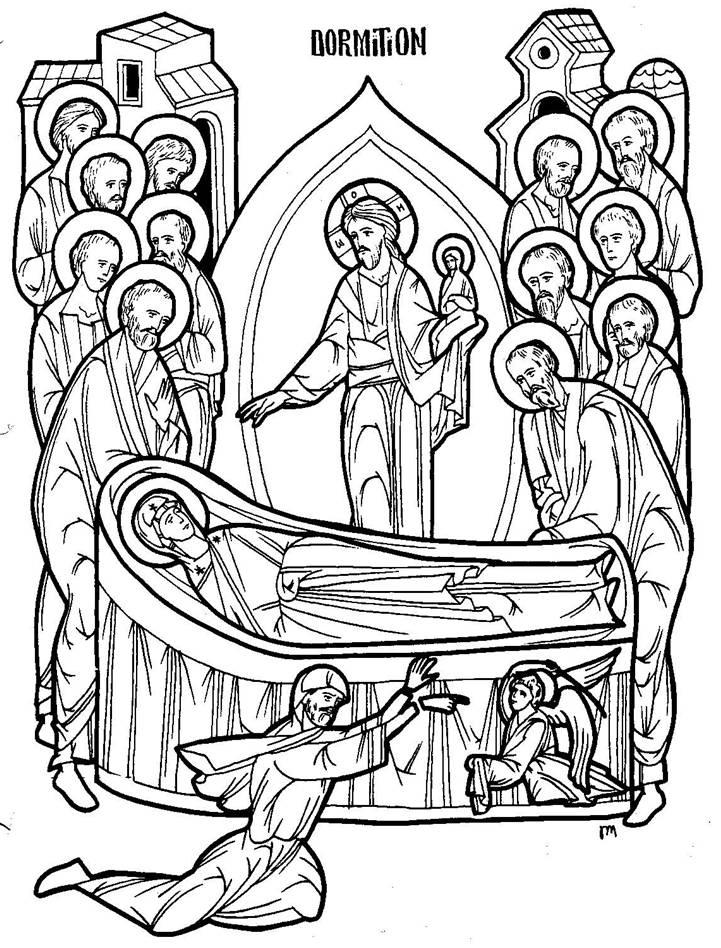Ages 8-10 Epistles,Feasts, Sacraments Overview
EPISTLES, FEASTS, AND SACRAMENTS
AGES 8-10
This sample schedule is provided for the benefit of Church School directors. Feel free to fill in your own dates and teachers!
Teachers:
Schedule of Classes:
|
Date |
Lesson/Activity |
Teacher |
Special Notes |
|
September 7 14 21 28 |
Nativity of the Theotokos Elevation of the Cross Romans Romans |
|
Memory Work: New Testament Books |
|
October 5 12 19 26 |
I Corinthians I Corinthians II Corinthians Galatians |
|
|
|
November 2 9 16 23 30 |
Ephesians Philippians Colossians Entry of the Theotokos I and II Thessalonians |
|
All Saints Party after Church School |
|
December 6 7 14 21 28 |
Tentative I and II Timothy Titus/Philemon Christmas Pageant Nativity of our Lord |
|
St. Nicholas Party
Parish and Nursing Home Painting of Holy Water jars |
|
January 4 11 18 25 |
Theophany Hebrews Hebrews James |
|
Three Kings Party after Church School
|
|
February 1 8 15 22 |
Meeting of the Lord I Peter II Peter/Jude I,II,III John |
|
Memory Work: 12 Major Feasts
Make Homeless bags
|
|
March 1 8 15 22 29 |
The Revelation Baptism Chrismation Annunciation Confession |
|
|
|
April 5 12 19 26 |
Palm Sunday Pascha No Church School Eucharist/Liturgy |
|
Candle Decorating Workshop
Pascha! Prosphora Workshop |
|
May 3 10 15-17 17 24 31 |
Marriage Orders Camping Trip ages 6-12 No Church School Ascension Pentecost |
|
Theme: Journeys of St. Paul
Make “Kneel-upons” Birthday Cake for the Church |
|
June 7 14 20 21 |
Holy Unction Requiem/Burial Play Rehearsal Closing Exercises |
|
Koliva Workshop After vespers, with overnight Play performance |
|
August 2 3-7 9 |
Transfiguration Vacation Bible School Dormition |
|
|
GENERAL NOTES:
Classroom supplies: Each class is supplied with the following items; if you use the last of something, please either replace it or let me know so I can replace it. If you need special craft supplies for your lesson, just submit the receipt to me for reimbursement:
Paper plates, small and large Scissors
Paper, plain and construction Tape and dispenser
Stapler and staples Paper bags
Glue Crayons and/or markers
Popsicle sticks Chenille sticks (Colored pipe cleaners)
Bible for each student 8x10 color print of icons of major feasts
Map of world in Paul’s day
There’s also lots of felt in the closet, 12x12 pieces of all colors; if you want to make banners, all you need to supply is the background piece and the hanging rod or coat hanger.
Teaching schedule: I have tried to accommodate any scheduling needs that you have communicated to me ahead of time in the schedule. However, we all know that there will be last-minute needs; please trade with someone if you cannot teach on your assigned day and then call me and let me know who’s traded with whom so I don’t panic at Liturgy when I don’t see you there!
Paperwork and insurance regulations: Each of us must “apply” each year for our volunteer position; our references will be checked as per diocesan regulations. We will also have a parent volunteer who could come into any classroom at any time as required by the insurance company.
Opening Exercises: Church School director will supervise this or delegate it when she will not be in church. Church School children and teachers are dismissed first from liturgy; children come straight across for snack during opening exercises and teachers can take 10 minutes to eat before coming over. We will review material from previous weeks, teach songs, rehearse plays, play games to augment lessons, or hear memory lessons during opening exercises. Memory work will also be done: books of New Testament and major feasts.
Curriculum: There are 3 types of lessons this year: feasts, epistles, and sacraments. While the theme of the lesson should be adhered to, the actual ideas in the curriculum are suggestions; if you have a creative idea for a craft or game or discussion (along the appropriate topic), please follow your own drummer. There should be enough here for you to work with; you can also play games as learning tools, such as “Jeopardy” or “Who Wants to be a Bible Scholar?”
For the benefit of the entire parish, when you teach a feast day lesson, please have the students design and make a felt banner. There are plenty of 12x12 pieces of felt in the closet to make letters, doves, people, etc.; just refill the bin if you finish off a color or let me know to purchase that color. We have 13 background banners with dowels attached. There are also adhesive felt letters for lettering. If you make these for each feast, we’ll have an entire set at the end of the year to decorate the Social Hall or Church School.
Church doesn't have space for banners? No problem! Why not take the icons provided with each feast lesson and give each student an icon for his icon corner at home by either:
- Print on paper and use Mod Podge to attach to wooden plaques, either stained or painted
- Print on shipping labels and attach directly to wooden plaques, then spraying with clear spray
For feast lessons, 2 other ideas you could use any week would be:
- Print the words to the Troparion on index cards, give each student a card, and see if they can line up in order; or
- Have them tell you the story, the first student giving one line, the next picking up where the first left off, etc. You can pass an object (e.g. ball) from student to student as each speaks.
For epistle lessons, there are several games that could be used any week to aid in memorizing the verses. On the week a verse is being introduced, write a few words on each of several index cards, give one to each student, and see if they can put it together. As more verses are learned, you can review your class’s verses (These are different at different age levels and therefore do not make good opening exercise material.) with several games:
- Epistle Bowl -- make 2 teams, the first player from one team begins a verse; can the first player from the other complete it? Give points to the teams; a cheap prize?
- Bible Advance – students line up against the opposite wall; mark a finish line about 15 feet away. Each player in turn must either finish a Bible verse you begin or recite a verse from your reference. If he is successful, he may advance one giant step toward the line (as big as he can). First player to reach the finish line is the winner.
- Musical Bible – Players are seated in a circle. A Bible is passed from player to player as music is played. When the music stops, the player must recite a verse of Scripture or he is out. No verse may be used more than once. The last player remaining in the circle is the winner.
- Missing part – Write each verse learned so far on an index card. Cut the cards in half. Hide the second half of each card all around the room. Hand out the first halves to the students and ask them to find their missing half (or halves). The first to find his portion of Scripture is the winner. When all are found, have students read all out loud to review.
For sacrament lessons, one effective tool any week is to write the parts of the service on index cards. Can the students put the service in order? I’m sure you will think of many other ideas!
Workshops: We have 5 workshops planned this year learning traditional Orthodox ethnic “skills” that coordinate with our curriculum: baking prosphora, making koliva, decorating holy water jars, making kneeling cushions, and decorating Palm Sunday candles. These will take place after Church School in the Church Hall.
Movie Nights and Parties: We will have supper after vespers on Saturday night while showing a small children’s movie. Older children should bring a sleeping bag for a lock-in with “feature” presentation; we must have at least 2 adults at each overnight.
RECIPES
CLAYS PAINTS
SALT DOUGH FINGER PAINT (4 WAYS)
2 cups flour Use pudding with food coloring!
1 cup salt Mix liquid starch and food coloring.
about 1 cup water Mix 3 T sugar, ½ cup cornstarch, and
food coloring 2 cups cold water. Cook over
bath oil, vegetable oil, peppermint oil low heat, stirring, till thick.
Mix flour and salt. Add water Pour into muffin tin. Add
slowly and mix with your fingers until food coloring to each cup.
it makes dough. Knead in a few drops
food coloring and a splotch of oil (if SAND PAINT
desired). Store in air-tight container. Add dry tempera paint to corn meal.
Sprinkle over areas “painted” with thinned glue
SELF-HARDENING CLAY
1 cup sand for a sand effect. Shake off excess.
½ cup cornstarch
1 tsp powdered alum PASTES
¾ cup hot water PRIMARY PASTE
Food coloring if desired Mix ½ cup water and 1 cup flour
Mix sand, cornstarch and alum in a bowl. Spoon into a jar
in large pot. Add hot water and stir or squeeze bottle to store.
vigorously. Add food coloring if
desired. Cook over medium heat PAPIER MACHE PASTE
until thick, stirring constantly. 3 cups water
After cooling, store in airtight container. 1 ½ cups flour
Mix flour with cold water until lumps are gone.
SAWDUST CLAY
2 cups fine sawdust Dip strips of newsprint in paste and mold around
1 cup flour surface to be shaped. Air dry.
Mix sawdust and flour in bowl
or bucket. Add a little water at a time,
stirring till it is stiff but pliable. Knead
till it’s elastic and easy to shape. Store
in airtight container. Air dry.
CORNSTARCH DOUGH
2 cups cornstarch
4 cups baking soda
2 ½ cups water
Mix cornstarch and soda in large
pot. Add water. Cook, stirring, over medium
heat until thick like mashed potatoes. After
cool, knead on wax paper for 5 minutes. Store
in an airtight container. Air dry.
Having trouble learning the 12 Major Feasts? Make a Feast Catcher and plan until you can name each icon. Can you also name the date?
- Print your Fortune Teller.
- Cut out the Fortune Teller along the outside line
- With the printed side up, fold the square in half horizontally and then vertically, open the folds.
- Turn the square over.
- Fold each corner over so they meet in the middle, do not let them overlap.
- Leave the square folded, and flip the square over.
- Now fold the corners into the center – make sure they do not overlap.
- Fold the entire square in half and poke your thumbs and forefingers in under flaps.
- Bring your fingers together so the Fortune Teller forms a peak –
Tiny icons to color are provided below for any projects you might want to do:
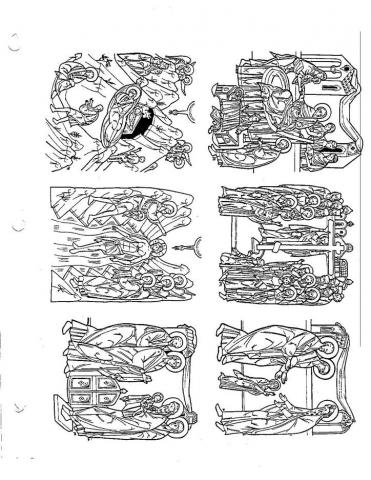
Nativity of the Theotokos
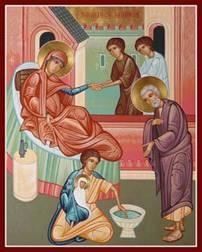
Objectives:
- Students should recognize the characters in the icon and tell its story.
- Students should know that we celebrate this feast on September 8.
Possible Lesson Plan:
- Open with prayer.
- Discuss the icon to see how much the students already know: St. Anna is the central figure, an elderly woman robed in blue and lying on a bed. The figures surrounding her are nurses. The Theotokos appears as an infant in the arms of a nurse being pondered by her mother and also with a nurse in a cradle being pondered by her father, St. Joachim, who appears in the lower right as an elderly man with white hair. Why are Joachim and Anna so old?
- Tell the story, if they don’t already know it:
Joachim and Anna were a righteous couple. But despite years of prayers, they had no children and were getting quite old, too old for children. They went to the temple constantly, praying and offering sacrifices for a child. Now, for the Jewish people, not having any children was considered a disgrace; the couple must be very wicked if God would not bless them even with a child. One day, Joachim brought yet another offering to the temple. The priest was so angry to see him yet again that he threw Joachim out of the temple. Joachim went to the hills outside the city and there prayed and fasted for forty days. An angel appeared to him and told him that they would have a baby, and this baby would be blessed by God. The angel appeared at the same to Anna at home. They ran to meet each other at the gates of the city, full of joy.
Nine months later, the baby was born. She was given the name Mary. The righteous couple promised the Lord that this child would be dedicated to Him; this promise was later fulfilled with the presentation of Mary at the temple. Tradition tells us that Anna was descended from Levi, of the priestly line, and descendant of Moses. Together – a couple blessed with the heritage of the greatest of the kings of Israel and the greatest of its prophets – king and priest. Little did they know that their grandson, Jesus, would be the King of Kings, the Messiah promised by the prophets, and the highest of all the High Priests.
- Scripture readings:
Gospel: Luke 10:38-end, 11:27-28
Epistle: Philippians 2:5-11
Old Testament: Genesis 28:11-17, Ezekiel 43:27-44:14, Proverbs 9:1-11
- Songs of the Feast:
Troparion: Thy nativity, O Theotokos, hath proclaimed joy to the whole universe; for from thee did shine forth the Sun of Justice, Christ our God, annulling the curse and bestowing the blessing, abolishing death and granting us life everlasting.
Kontakion: By thy holy birth-giving, O pure one, Joachim and Anna were delivered from the reproach of barrenness; and Adam and Eve were delivered from the corruption of death; thy people do celebrate it, having been saved from the stain of iniquity, crying unto thee, The barren doth give birth to the Theotokos, who nourisheth our life.
- Discussion questions:
Why is this feast first in the liturgical year? What is the importance of the Theotokos? In what way, does our hope begin here?
What are some other stories of women who prayed and were granted by the Lord “miraculous” babies? (Sarah, Hannah, and later, Elizabeth) In what way do Joachim and Anna fulfill Adam and Eve? How does Jacob’s ladder (Genesis 28) relate to the Theotokos? (She is the ladder who reunites heaven and earth.)
What does the reading from Philippians, which doesn’t even mention Mary, have to do with her feast? God empties Himself (known as “kenosis”) to become human; Mary is the instrument of this Incarnation.
7. Make a felt banner: Buy ahead of time a piece of background color felt of your choosing (about 24x36 inches). Turn down about 1 inch at the top and staple around a coat hanger or dowel. Or use one of the pre-made banners. Have the students design a banner to illustrate the feast – its icon or its theme (the cross), etc. – with the name of the feast somewhere on it. Use the small pieces of felt to cut out figures and letters and glue on. We have felt letters with adhesive for ease in use. Hang in the Social Hall for all to enjoy! Here are just some ideas, but use your own creativity:
8. Close with prayer.
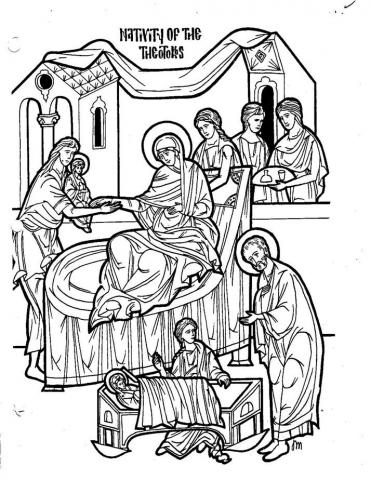
Elevation of the Cross
THE ELEVATION OF THE HOLY CROSS
Objectives:
- Students should be able to identify each character in the icon, telling the story.
- Students should know the Troparion of the Holy Cross and “Before Thy Cross”.
- Students should know that the date of the feast is September 14.
Possible Lesson Plan:
- Open with prayer.
- Review the icon of the feast: St. Macarius is in the center holding the cross, Helen on the left with crown, Constantine on the right with crown, citizens of Jerusalem, and the city of Jerusalem in the background with the domed Church of the Holy Sepulchre right above the Cross. You might begin and ask what the students already know about the story and its participants, setting the stage for the telling of the story.
- Review the story of the finding of the holy cross, first reminding students of the historical context (Who was Constantine? What did he do? What was the Council of Nicaea and its outcome?):
This feast originated on the occasion of the finding of the cross on which Jesus was crucified. This event, according to early Christian historians, occurred during the time of Constantine the Great. He, feeling a great reverence for the Cross of Christ because it had brought him many victories and also desiring to express his thankfulness to God for the peace in the church after the first Ecumenical Council of Nicaea in 325 AD, decided to erect a church on Golgotha. This is the place where Jesus was crucified, along with the two thieves.
To lay the groundwork for this project, Constantine's mother Helena journeyed to Jerusalem in 326. Upon arriving in the Holy City, she was struck with a deep desire to find, if that was possible, the Cross of Jesus. She learned that it was the custom of the Romans of Jesus' time to bury the crosses near the spot upon which the executions had taken place - this information was sup-plied to her by an elderly Jewish man who had spent his entire life in the city. In addition, she was told that the Holy Cross was beneath a pagan temple, erected by the Roman Emperor Hadrian many years before. Helen had the temple torn down and set about the task of excavation, digging. The troops who did the actual digging pleaded with her after a while to give up her dream, for they kept finding nothing in the ground but ancient pottery. St. Helena, however, insisting upon her royal privileges, prevailed and work continued. Finally, the soldiers found not one but three crosses. It was not possible to know upon which of the crosses the Lord Jesus had been crucified, for the tablet with the superscription "Jesus of Nazareth, King of the Jews" was found separately.
There was naturally great excitement in the city with the news that the crosses had been found, but no one could figure out a way of discovering which of the three was the Cross of Jesus. But the Patriarch of Jerusalem, Macanus, was an inspired man. He ordered a very sick but pious woman to be brought to the place, and there -in the presence of the Queen and a great crowd of people - proceeded to touch the sick woman with each of the crosses. The first two accomplished nothing, but when the third one touched her - she was healed of her sickness, made whole.
When they were bringing the crosses back to the city - for at that time Golgotha was still "outside" Jerusalem, as it was the Roman custom to perform crucifixions on the outskirts - a more wonderful miracle took place which conclusively proved which of the three crosses was Christ's. The procession heading into the city, led by Patriarch Macarius, ran into another procession -heading away from the city, a funeral. The patriarch again went through the same procedure as he had with the sick woman, but this time with the man who was being buried. When the third cross touched the dead man, he awoke, as if from sleep.
With the news of these two great miracles, crowds and crowds of people began piling into Jerusalem. Because of the size of these crowds, and the smallness of the Cathedral Church, it was not possible for everyone to even see the Cross, let alone venerate it. So the next day, the Patriarch and a number of his deacons raised up the Cross over their heads during the service so that all could see - and all the people began singing, over and over, "Lord, Have Mercy." Thus was born the custom, lasting to the present day in some churches, of singing these same words over and over when the Cross is lifted during the services on this day. The Church of the Holy Sepulchre was built on the site where the true cross was found.
But the special hymn of the days during which the Cross is in the center of the church is "Before Thy Cross, We Bow Down In Worship, 0 Master, and Thy Holy Resurrection, We Glorify!" This hymn even replaces the Trisagion ("Holy God") during the Divine Liturgy on these days. This hymn originated some ten years after the above finding of the Cross, when a Church of the Resurrection of Christ was consecrated in Jerusalem in 335 A.D. Many Bishops came from all over the world to consecrate this church to God, and when they returned to their home parishes this hymn went with them.
Why “basil” at the Feast of the Cross? The herb, basil has long been associated with the feast of the Exaltation of the Holy Cross. The word “basil” is derived from “Vasileios,” the Greek word for a king or person of royal lineage.
According to the liturgical tradition, the Holy Empress Helena, Mother of the Saint and King Constantine, found the location of the True Cross by digging for it under a large growth of basil. Basil plants were reputed to have sprung up at the foot of the Cross where the Precious Blood of Christ fell, along with the tears of the Mother of God. On the Feast of the Exaltation of the Holy Cross it is customary in the East to rest the image of the Holy Cross on a bed of basil before carrying it out for the veneration of the faithful. Also, in some areas, branches of basil are used throughout the temple as a festive decoration as well as to provide a heavenly scent in honor of the Feast. Blessed basil leaves may also be arranged in a bouquet at the foot of the “Golgotha” cross. Dried leaves taken from the feast can also be used by the faithful as a sweet incense to burn at home as a blessing.
Why not plant some basil today in an egg carton to take home and water? Plant it next spring in the yard and have a lovely plant for next year’s feast. Or, if you already planted it last year when we studied the finding of the cross, it's time to harvest and bring to church!
- Read the gospel and epistle readings for this feast (have students read aloud in turns):
John 19:6-35
I Corinthians 1:18-24 – What does Paul say about the importance of the cross?
Old Testament Scriptures regarding the Holy Cross:
Exodus 7:5, 7:19-20, 8:6-22, 10:21-22, 14:21,26, 17:11-12
Numbers 2: 2-31
- How many New Testament references to the cross can you find? This can be a contest, with a time limit. Have each student select one or more and read – no repeats!
6. A Musical Feast (Sing them, if you’re so inclined.):
Troparion: O, Lord, save thy people, and bless thine inheritance. Grant victory to all Orthodox Christians over their adversaries and by virtue of thy cross preserve thy habitation.
Kontakion: Do thou, who of thine own good will wast elevated upon the Cross, bestow thy bounties upon the new people which is called by thy Name, O Christ our God; make glad with thy might our believing kings, granting them victory over their adversaries. May thine aid be a panoply of peace, a trophy invincible.
In place of the Trisagion: Before thy cross, we bow down in worship, O Master, and thy holy Resurrection we glorify.
Exapostilarion: The cross is the preserver of all the universe.
The cross is the beauty of the Church.
The cross is the might of kings.
The cross is the steadfastness of believers.
The cross is the glory of the angels and the sting of Satan.
- Discussion questions:
What are some Old Testament “forerunners” of the cross? How was the cross (and the crucifixion) predicted in the Old Testament? In what way was the cross the fulfillment of the Old Covenant?
Who is our adversary? How is the cross the sting of Satan? How did the cross preserve the universe?
Where do we see the cross, in church and elsewhere? What are some words that contain the word “cross”? (crossroads, crosshairs, crosswalk) Any significance?
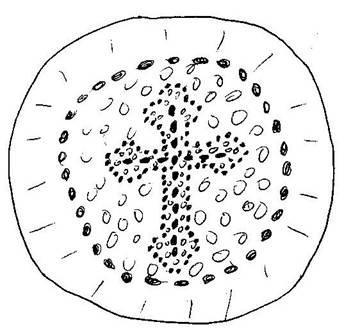 Craft Idea – Seed Mosaic: Take a
Craft Idea – Seed Mosaic: Take a
paper plate. Have students draw
on it a cross, style of their choosing.
Bring to class lots of different colors
and shapes of seeds and beans.
Have students glue on seeds and
beans in mosaic form.
- Make a felt banner as before.
10. Close with prayer.
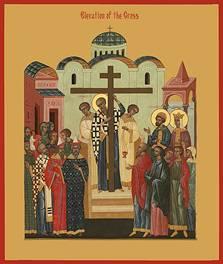
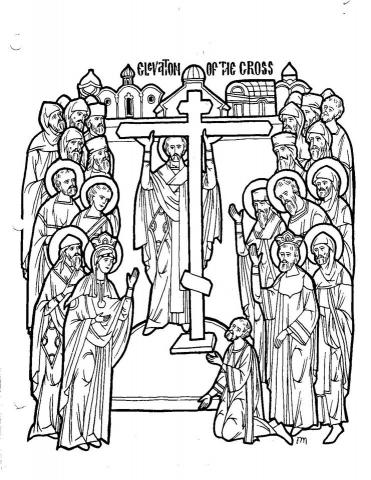
Romans: Doing Good
ROMANS 7:19
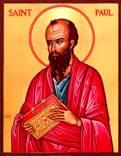
Scripture verse: “For the good that I will to do, I do not do; but the evil I will not to do, that I practice.”
Objectives:
- Students should memorize the verse and understand its meaning and context.
- Students should understand what a saint is and the work that entails.
Background on the book:
The letter to the Romans was written by the Apostle Paul around AD 55-57 while he was in Corinth on his 3rd missionary journey. Since there was no public post office in the Roman Empire, Paul used the upcoming visit of a Christian in Corinth, Phoebe, to Rome by ship to send his letter. He addressed his letter to all believers, both Jews and Gentiles, living in Rome. Paul had not yet visited Rome, but he wanted to share a detailed explanation of the Gospel message. He hoped to visit Rome after he went to Jerusalem; in fact, he did visit Rome but not in the way he had planned. (How?) Find Rome, Corinth, and trace Paul’s 3rd missionary journey on a map.
Possible Lesson Plan:
- Open with prayer. The Lord’s prayer would be particularly appropriate. Can each student recite it?
- Review the background on the book. Who wrote it? To whom? Why?
- Scripture Lesson: Read Romans 7:15-25. Read this “round robin” if you have good readers. Then have each student find and read a related verse: Romans 8:26-28, Matthew 26:31-36, 69-75, Matthew 21:28-32. Can you think of some Old Testament characters who also said they would do something and did not follow through? (Jonah would be a good example.) In the reading from Matthew, how did Peter fail to keep his promise? Why did he fail? How did he feel? What was God’s response?
- Have each student recite the verse. Having trouble? Line up the students as in Mother May I at the back of the room. Each student gets to take a "giant step" if he is able to give the next word in the verse.
- Group activity: Have everyone stand up with both feet on the floor. Each time they answer “yes” to one of the following questions, they must lift a foot. Is anyone standing at the end?
Have you ever said you would get up right away, then slept another 10 minutes?
Have you ever broken a New Year’s resolution?
Have you ever gotten home later than you promised?
Have you ever promised to study, then watched TV or read a book?
Have you ever told your parents you would clean your room, and not done it?
Have you ever told someone you forgave them, but stayed angry?
Have you ever promised a friend that you would keep a secret, then told it?
Why might you do these things? How do you feel when others do not do what they say they will do? (sad, betrayed, angry, etc.) How do you think others feel when you fail to keep your promises?
6. Icon activity: Before class, take some small, cheap icons of the saints, cover them with clear plastic (e.g. contact paper), and then smear them with mud until you can’t see who they are. Let the mud dry and bring them to class. Tell the students that this is an icon. What’s wrong with it? What is a saint? What does the mud represent? (sin) How can we reveal the image of the saint? Begin to scratch off the mud, bit by bit. Is it easy to see the real saint? Are we called to be saints? Can we do this by ourselves? (See Romans 8: 18-19, 26) What are some ways we can help the Holy Spirit to work in us this miracle of sainthood? (Brainstorm here: prayer and more prayer, loving each other even in our muddied condition, sacrificing our own pleasure for another’s, etc.) Have the students take home their icon, scratch off the mud, and research the life of the saints they see. How did this saint put off sin and put on holiness?
7. Close with prayer.
Romans: The Branches
ROMANS 11:17-18
Scripture verse: “And if some of the branches were broken off, and you, being a wild olive tree, were grafted in among them, and with them became a partaker of the root and fatness of the olive tree, do not boast against the branches.”
Objectives:
- Students should understand the metaphor of the olive tree.
- Students should understand the relationship between Judaism and Christianity.
Possible Lesson Plan:
- Open with prayer.
- Scripture lesson: Read aloud Romans 11:1-5, 16-20, John 15:1-8. Who is the olive tree? The vine? What is the process of grafting? What is the root of the olive tree? (Israel) Who are the branches? What happens to an unbelieving branch? Now work on memorizing the verse. This week, print the verse twice and cut into phrases. Make two teams, and see which can put the verse back together fastest.
- Review again the background on the book. Who was Paul? Was he Jewish or Gentile? What is his Jewish name? Who did he preach to? What was the controversy facing the early Church between Jews and Gentiles? Had God forsaken His chosen people, the Jews, in favor of the Gentiles?
- How did God prepare the Jews for the coming of Jesus? Review the history of the Jewish people – the choosing of Abraham, the miraculous birth of Isaac, the salvation from Egypt through Moses (How is the Passover a forethought of Jesus?), the wandering in the desert, the formation of a nation with Saul and David. Does being a member of a chosen nation ensure faith? Does being born in a Christian home ensure faith either? How did God speak through the long line of prophets calling His people back to Him (Can you name some?) What were some specific prophecies about the Messiah? How did Jesus fulfill them? Then why didn’t all the Jews believe in Him? Do we always listen when we hear about the Lord in Church or Sunday School either?
- Review the first Ecumenical Council in Jerusalem: Acts 15:6-21. What issues were faced? What was decided? Did Gentiles have to become Jewish to become Christian? Did they have to obey all the Jewish Law? Were they somehow second-class citizens as “grafted in branches”? Were they better than the Jews?
- How then should we relate to Jews today? Does anyone know anyone who is Jewish? What is special about being Jewish? Do they still need to hear about Jesus?
- Craft idea—Make a Jesse Tree: For a 3-dimensional tree, take a branch from a tree or shrub that looks sort of like a small tree. Assign each student an Old Testament forebear of Jesus to illustrate on a small paper plate. Punch a hole in the top of each “ornament” and with yarn or string hang on the “tree”. For a wall hanging, take a large piece of light-colored felt. First draw on it with marker or paint a large tree. Students should make small felt figures of Old Testament forebears of Jesus. These can be stuck right on the tree.
8. Close with prayer.
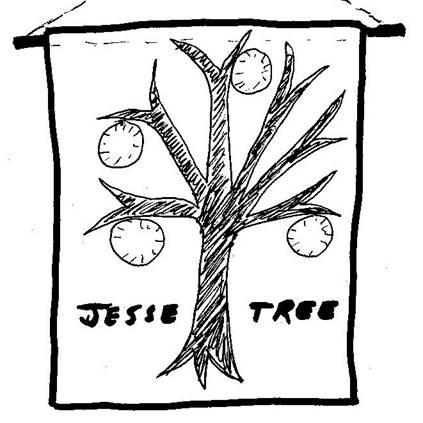
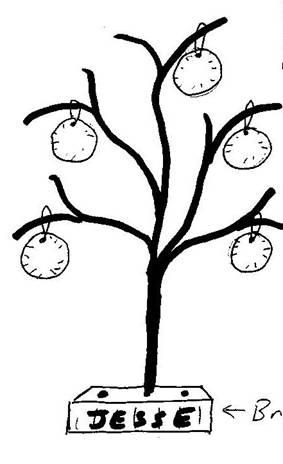
1 Corinthians: Christ Crucified
I CORINTHIANS 2:2
Scripture verse: “For I am determined not to know anything among you except Jesus Christ and Him crucified.”
Objectives:
- Students should memorize the verse and know that Jesus was crucified for our sins.
- Students should know that the cross is an important symbol of Christianity and why.
Background on the book:
This letter was written by St. Paul to the struggling church at Corinth while he was staying in Ephesus for 2 ½ years during his third missionary journey around 55 AD. Paul had visited Corinth for about a year and a half during his second missionary journey and planned to visit again the following winter. Corinth was one of the greatest trading centers of the world. It was located on a 4-mile-wide isthmus separating northern and southern Greece; because of the dangers of sailing around the tip of Greece, many ships were pulled out of the water at Corinth and hauled on rollers across the land bridge! Corinth was famous for its markets and luxuries, but also for drunkenness, pagan idols, and immorality. The young church there had serious problems dealing with these issues. Find Corinth on a map.
Possible Lesson Plan:
- Open with prayer.
- Review the background of the book.
- Scripture lesson: I Corinthians 2:2, 1:18, Galatians 6:14, Romans 5:8-9. Find these and read them aloud. Begin to memorize the verse; this is an easy one. Have a large beach ball, and students sit in a circle and toss the ball -- each must give the next word of the verse when he receives the ball.
- Discuss the concept of sin: What is it? What are some sins? Have we ever sinned? Did Jesus ever sin? What do our earthly parents do if we sin? Would it be only fair and just for God to punish us for our sins? Instead, who was punished?
- Review the events of Holy Week leading up to Jesus’s crucifixion. Why is the cross a symbol of our salvation? Why is Jesus called the Lamb of God? How are we forgiven for our sins? Remind the students that the story ends, not with the crucifixion, but with the empty tomb!
- Review that great song: “Before Thy Cross” and the Troparion of the Cross.
Before Thy Cross O Lord, save thy people
We bow down and worship And bless thine inheritance.
O, Master Grant victory to all Orthodox Christians
And thy holy resurrection Over their adversaries.
We Glorify! And by virtue of thy Cross
Preserve thy habitation.
Why do we bow down before the cross? How does the cross save us?
- Why is the cross “foolishness”? When we share Jesus with our friends, do we focus on the cross and only the cross, or on Orthodoxy, the ritual, our Church, etc.?
- Make a cross necklace: Take a small wooden cross shape (available at craft stores), or a piece of foam cut in the shape of a cross, or cut a cross shape out of styrofoam (e.g. meat trays you can ask the Giant to give you for free). If you have a wooden cross, you can paint and then use Mod Podge to attach a small icon of the cross right in the center. More simply, decorate with paint or markers, rhinestones, sequins, pearls, whatever. Make a hole in the top and string as a necklace. Will wear the cross every day to school and, if asked, tell your friends and teachers how Jesus died on the cross? Next week, tell us what happened.
9. Close with prayer.
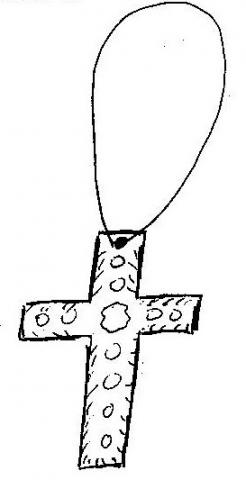
1 Corinthians: Members of the Body
I CORINTHIANS 12:14
Scripture verse: “For in fact the body is not one member, but many.”
Objectives:
- Students should be able to recite the verse and understand the analogy of the Church to the human body.
- Students should begin to see their own gifts and function in the body.
Possible Lesson Plan:
- Open with prayer.
- Scripture lesson: I Corinthians 12: 12-21. Read it aloud with each student taking a turn. Read also Romans 12:1-13, Matthew 25:14-30. Read and discuss. Similar? Different? Our memory verse today is quick and easy as well. Use this week to review our verses so far. Play musical chairs; when the music stops, if the student left standing can recite one of our verses, he can stay in the game!
- Review the background of the book. What were those silly Corinthians doing now that has Paul all riled up? Each one is busy thinking that his ministry is the best and most important, boasting and putting others down!
- Discuss human anatomy (at an appropriate level): What is the function of the various parts of the body? Draw a body on a large piece of paper or chalkboard as you talk, adding each part and discussing its function. Are the parts alone worth much? Are they even pretty to look at? Can a nose by itself do anything at all? Play 20 Questions: Can you guess what part of the body I am?
- In what way can the Church be called the body of Christ? How does Jesus work in the world today? (through us) Do we all have the same talents? Have each student make a list of his special talents and interests and share them; are they all the same? (e.g. serious, funny, talkative, shy, good at math or music, enjoy reading, sports, crafts, art, etc.) Take the list and tie it with a ribbon, scroll-like, and place in a basket in the center of the table. How do our special talents and interests become gifts? (when we give them away!) Are we all the same? Would a shy person be the best choice for an evangelist? What talents would make a good choir director? A good child watcher? A good Sunday School teacher? A good treasurer? Are they the same? Can you think of a particular way your own special talents could serve the Lord? Are some ways of serving the Lord more obvious than others? (e.g. the priest, choir director, etc.) Are they more important than the person who counts the money, or rings the bell, or visits the sick, or folds bulletins? Are you a foot or a nose?
- Make a marionette. Cut out the body
parts from poster board and punch holes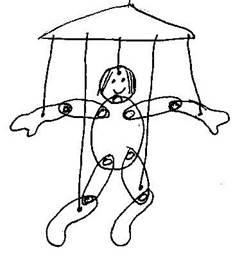
for brads and strings ahead of time. Have
students color and decorate with yarn,
fabric, ribbon, etc. Then put together
with brads at the joints, tie on the strings,
and use a coat hanger to hang. Of course,
discuss the Scripture lesson while working
on the puppets.
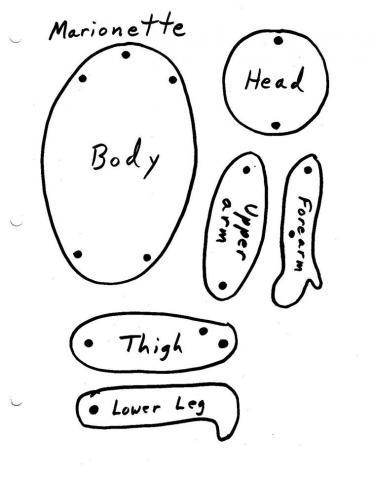
- Apostles
- Prophets
- Teachers
- Miracles
- Gifts of Healing
- Helps
- Administrations
- Tongues
Punch holes in heads of people and around edge of plate and hang with string or yarn.
- Close with prayer.
2 Corinthians: Cheerful Giver
II CORINTHIANS 9:7
Scripture verse: “So let each one give as he purposes in his heart, not grudgingly or of necessity; for God loves a cheerful giver.”
Objectives:
- Students should memorize the last part of the verse and understand its context.
- Students should personally fill out a pledge card with their promise to God.
Background on the book:
This letter was written by St. Paul in the same year as I Corinthians, after he received a report from Titus about the state of the church in Corinth. Paul had now left Ephesus, having been almost killed in the great riot, and was visiting the region of Philippi and Thessalonica. The problems of immorality and idol worship had been dealt with, but new problems were surfacing. Paul sent Titus right back to Corinth with his response. Among the problems he addressed was that the Corinthians had promised to send money to help the Christians in Jerusalem; now a year later those who had promised were not paying. Later that year, Paul himself would visit Corinth, and there write the letter to the Romans. Find Corinth, Ephesus, Philippi, and Thessalonica on a map.
Possible Lesson Plan:
- Open with prayer.
- Review the background of the book. What problem was Paul addressing in this part of his letter?
- Scripture lesson: II Corinthians 9:5-8. Read this aloud. Then read Luke 21:1-4. "God loves a cheerful giver" is certainly the easiest memory work so far this year. Repeat it several times.
- Tithes and offerings: Have you ever promised to give to something and then never followed through? Maybe a collection for the Sunday School during Lent or to a missionary or needy child? How much of our lives do we owe to God? How much does God ask us to give? (a tithe is 10% of our income, but an offering is out of our own generosity) Do we have to be rich to give? With what attitude does God want us to approach giving – grudgingly or willingly? Is that how we usually feel when we give?
- Our own personal pledge: In our Church, we make our promise to God about tithes and offerings of money and talents (Remember the last lesson?) on a pledge card. No one is too young to give to God and no gift is too small. Do you have any money of your own? (Brainstorm here: allowance, chores, etc.) How much does each of you want to promise to God? Fill out pledge cards.

- Make a church bank to keep your tithes and offerings. Take a small milk carton or small box (e.g. microwave popcorn box); they don’t all have to be the same. Cover the walls and top with construction paper or felt– red for brick or gray for stone, etc. Cut out windows and color brightly as for stained glass. Glue windows on walls; cut out a door from brown paper or felt and glue on. Add a chenille cross on the top and cut a slit for money.
- Close with prayer.
Galatians: Sowing and Reaping
GALATIANS 6:7
Scripture verse: “Do not be deceived, God is not mocked; for whatever a man sows, that he will also reap.”
Objectives:
- Students should memorize the verse and understand the parable of the sower.
- Students should understand the concept of “relative morality” and its application today.
Background on the book:
St. Paul wrote this letter to believers in the region of Galatia from his home church in Antioch, just before the first ecumenical council in Jerusalem. (What did that council decide? The obligations of Gentile believers to the Jewish law) Paul had started the churches in Galatia during his first missionary journey around 48 AD. But, after he left, some believers had been convinced that they had to obey all the Jewish law for salvation; Paul writes to correct this. But, others in Galatia were deep in sin, believing that since they were saved by faith, it didn’t matter what they did! Even though the book comes after the letters to the Romans and the Corinthians, it was written before those epistles, probably just as he was starting his 3rd missionary journey.
Possible Lesson Plan:
- Open with prayer.
- Review the background on the book: When and where was it written? Find Galatia on the map.
- Scripture lesson: Galatians 6:4-10, Exodus 20:1-20, Luke 8:4-15 – How can our lives be compared to sowing seeds? What is good seed? What is the reward for sowing good seed? Bad seed? Have you ever seen someone doing something wrong and seeming to get away with it? Are there consequences for their actions or should we just join them in doing what we can get away with? With older children, review the story of David and Bathsheba; did David get away with his sin in the long run? Who caught him? (God, through Nathan the prophet) With younger children, Jonah would be a better example: Did he think he got away with not obeying God? Did he really?
Memorize the verse. It's a long one today. Try printing it out, cut into phrases, and tape to backs of students. They must line themselves up in the correct order!
- Read Exodus 20:1-20: What are these popularly called? (the Ten Commandments) Why did God give His people the Law? Are we saved by the law? Does that mean we can do anything we feel like without regard to God’s commandments? Are the commandments given to make our lives miserable and no fun, or because these guidelines are actually the best way to live? What if God had called these the Ten Suggestions instead of the Ten Commandments?
- Is there really such a thing as right and wrong? Or are these old-fashioned concepts and people can really decide for themselves what is “right for me”? Is there a right or wrong in these situations:
If you had a chance to cheat on a test without being caught, would you?
If your parents told you not to go somewhere, would you go anyway?
If your friends dared you to walk out of a store with a CD without paying for it, would you try to?
If you were asked to donate money to an abortion clinic, would you?
If you were asked to do a book report, would you watch the movie and write it based on that?
If you had a chance to go to the mall instead of to Church on Sunday, would you?
Discuss the concept of relative morality: In the eyes of the world around us, is there any true right and wrong? In God’s eyes?
- Do a Sowing and Reaping project: Give each student an egg carton. Fill compartments with dirt. Have a variety of seeds, unlabelled. Students should sow seeds, one type in each compartment. Water and take home; water carefully in a sunny window. What’s growing? Are all the plants the same?
No space for dirt and egg cartons? Try this paper craft. Print on cardstock, cut out both circles, including the little wedge from the top circle, use a brad to put them together. Now review the 10 commandments as our priest often does with us when preparing for general confession.
7. Close with prayer. The Lord’s prayer would be appropriate here, with special emphasis on “deliver us from evil”. Ask the students to watch a favorite TV show this week and count the incidents of disobedience to the 10 Commandments.
Ephesians: The Fullness of God
EPHESIANS 3:18-19
Scripture verse: “that you, being rooted and grounded in love, may be able to comprehend with all the saints what is the width and length and depth and height – to know the love of Christ which passes knowledge; that you may be filled with all the fullness of God.”
Objectives:
- Students should memorize the last half of the verse and understand its content and context.
- Students should reconsider how much Christ fills their lives and reconsider their priorities.
Background on the book:
Ephesians was written while Paul was a prisoner in Rome 61-63 AD. He wasn’t busy and had lots of time to write a letter from his heart. The letter itself was carried to Ephesus by Tychicus, who was also carrying the letter to the Colossians and had with him Onesimus with the letter to Philemon.
Possible Lesson Plan:
- Open with prayer.
- Review the background of the book. Find Ephesus, Rome, and Colossae on the map.
- Scripture lesson: Ephesians 3:12-21, Luke 9:23-25, 12:29-34. Discuss. A very long verse, but work on the last part for memorization. Recite it a few times: "filled with all the fullness of God."
- Take a large piece of paper or a blackboard. Divide it into hours like an appointment book for a “sample day” – e.g. Monday. Have the students fill in the sample day based on their usual schedule – e.g. 7 AM get up and get dressed and have breakfast, 8 AM-3 PM go to school, 4-6 PM soccer (or ballet, etc.), 6 –7 PM dinner, 7-8 PM homework, 8-9 PM watch TV, 9 PM go to bed, 10 PM-7 AM sleep. What percentage of the day does the Lord get? Does God fill our day with all His fullness? Does how we spend our time show what is important to us? How often and for how long do we:
Pray?
Worship in Church?
Attend youth or Church School classes or activities?
Serve the Lord by serving others?
- Reread the 10 Commandments from the last lesson: What is the first commandment? Why? What crowds out God in your life? Has this become your “god”? Look back on the hypothetical schedule: How can it be “reprioritized”? Some things are unchangeable (e.g. sleep and school) but some are not. Hand out copies of the “Daily Schedule” and let students fill them in, reflecting their new priorities.
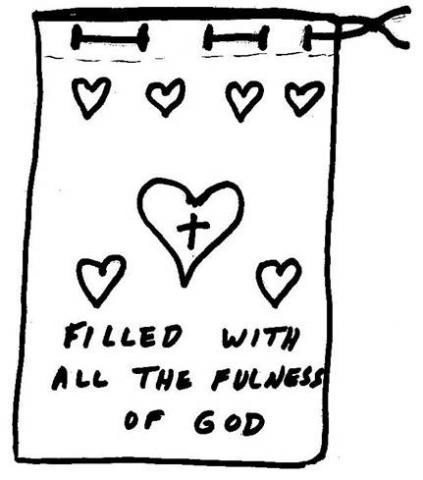 Make a “Pillowcase Tote Bag”: Begin with a pillowcase for each student with holes cut around the top at about 3 inch intervals or buy blank canvas tote bags. Students should decorate the bags with hearts (fabric paint, fabric markers) to represent the love of God and the words “FILLED WITH ALL THE FULNESS OF GOD”. Take a length of macramé cord or clothesline and weave in and out of the holes to make a tote bag.
Make a “Pillowcase Tote Bag”: Begin with a pillowcase for each student with holes cut around the top at about 3 inch intervals or buy blank canvas tote bags. Students should decorate the bags with hearts (fabric paint, fabric markers) to represent the love of God and the words “FILLED WITH ALL THE FULNESS OF GOD”. Take a length of macramé cord or clothesline and weave in and out of the holes to make a tote bag.
- Close with prayer: Pray especially that the students will be filled with the Lord this week.
MY DAILY SCHEDULE
|
|
MON. |
TUES. |
WED. |
THURS. |
FRI. |
SAT. |
SUNDAY |
6 AM
|
|
|
|
|
|
|
|
7 |
|
|
|
|
|
|
|
|
8
|
|
|
|
|
|
|
|
|
9
|
|
|
|
|
|
|
|
|
10
|
|
|
|
|
|
|
|
|
11
|
|
|
|
|
|
|
|
|
Noon
|
|
|
|
|
|
|
|
|
1 PM
|
|
|
|
|
|
|
|
|
2
|
|
|
|
|
|
|
|
|
3
|
|
|
|
|
|
|
|
|
4
|
|
|
|
|
|
|
|
|
5
|
|
|
|
|
|
|
|
|
6
|
|
|
|
|
|
|
|
|
7
|
|
|
|
|
|
|
|
|
8
|
|
|
|
|
|
|
|
|
9
|
|
|
|
|
|
|
|
|
10
|
|
|
|
|
|
|
|
|
11
|
|
|
|
|
|
|
|
Philippians: Lowliness of Mind
PHILIPPIANS 2:3
Scripture verse: “Let nothing be done through selfish ambition or conceit, but in lowliness of mind let each esteem others better than himself.”
Objectives:
- Students should memorize at least the first half of the verse.
- Students should understand that doing the right thing for the wrong reason is not God’s way.
Background on the book:
This letter was also written by St. Paul while he was a prisoner in Rome in AD 61-63. The Church in Philippi had been founded by Paul around 50-51 AD during his visit on his 2nd missionary journey (Remember the jailer in the earthquake?); this was the first church on the continent of Europe! St. Luke, author of the gospel of Luke, was the priest of Philippi during its first 6 years. Paul had visited Philippi twice again during his 3rd missionary journey, AD 57-58. When the Philippians had heard that Paul was in prison, they sent Epaphroditus with a gift of money to make his stay more comfortable. While in Rome, Epaphroditus almost died, but he was healed and returned to Philippi, taking Paul’s letter back with him. In Philippi, many believers who had previously been too shy to speak were now preaching the Gospel boldly. But others were preaching in order to make Paul look bad or to make a name for themselves. While Paul is happy that the gospel is being preached, no matter by whom, he knows that the Lord sees into the heart of the believer and knows our motives. God does not want us to be self-centered, but to serve him in humbleness. Find Philippi and Rome on a map – a short journey?
Possible Lesson Plan:
- Open with prayer.
2. Review the background of the book.
3. Scripture lesson: Philippians 2:3. Read it aloud together and memorize it. Read also I John 1:5-7.
Memorize the first half of the verse. Try Word Bounce: Using your large beach ball, toss it from student to student; the student with the ball must give the next word of the verse.
4. Have you ever known anyone who did the right thing for the wrong reason?
Look at the story of Pharoah and Moses; why did Pharoah let God’s people go? Look again at Jonah: even after he obeyed God, he was upset at God. Why? (Jonah 4:1-4) Did Jonah really go to Ninevah with the Lord’s desire to save the city, or to make himself look good?
5. Have you ever done the right thing for the wrong reason? What is wrong with these situations?
You come to Church in your nicest clothes because you want everyone to see how good you look.
You sing in the choir so everyone can hear your lovely voice.
You share a lot in Sunday School so everyone will know how smart you are.
You help at the soup kitchen so everyone will know what a good Christian you are.
You come to Church every Sunday so everyone will see how obedient you are.
You tell your friend about Jesus so you can bring him to Church next week
and show everyone how much you love the Lord.
- Try a light and darkness activity. Turn out the lights and ask each student to assume a funny position. Do they feel silly in the dark? Turn on the lights. Do they feel silly or embarrassed in the light? Remind them that in Christ we walk in the light.
- Make a candle holder from clay: Use white air-dry clay that can be used with candles or flames. Make a pinch pot large enough to hold a votive candle or tea-light candle. If the clay is white, you can decorate these with markers saying “Jesus is the light of the world” with big suns or stars over them. Put candles in them and light the candles. Turn out the lights; is it dark now?
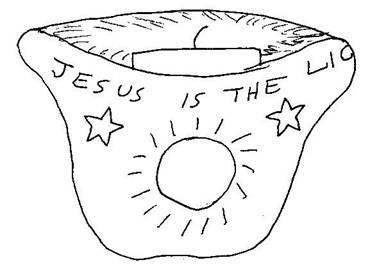
- Close with prayer.
Colossians: The Lord and Not Man
COLOSSIANS 3:23
Scripture verse: “And whatever you do, do it heartily, as to the Lord and not to men,”
Objectives:
- Students should memorize the verse and understand its context and content.
- Students should understand what it means to serve the Lord, whether one receives earthly recognition or not.
Background on the book:
The letter to the Colossians (Where is Colossae?) was also written while Paul was a prisoner in Rome. It is unique in that it was written to a group of believers whom Paul had never even met! Paul had sent Epaphras to Colossae years before (while Paul himself was in Ephesus on his 3rd missionary journey) with the news of the gospel and a church was started. Now Epaphras has come to Rome to tell Paul that the young church is having troubles. But, while in Rome, Epaphras was also imprisoned and Paul had to send his return letter with Tychicus and Onesimus, along with the letter to the Ephesians.
Possible Lesson Plan:
- Open with prayer.
- Review the background of the book. Look for a moment at Epaphras: Was he famous? Anyone even heard of him before? But Paul recognizes him in this letter as a faithful servant of the Lord; in fact, until Paul mentioned it (Ephesians 4:12-13), no one in Colossae even knew he was praying for them and had been imprisoned.
- Scripture Lesson: Colossians 3:23-24, Matthew 6:1-4. Read these together. Discuss their meaning. Repeat the verse a few times, then try a quiz on all of our memory verses so far. Try "Paul says" by having students stand in a row. Teacher begins: Paul says...if...then give either a correct verse or one with the words made funny or turned around...is right then pat your head". If the verse is correct, the students should do the action. If the verse is wrong, just as in Simon says, they should not.
- Look through the Bible for examples of humble and quiet service: What about Hannah, Ruth, Dorcas? Have you heard the story of Corrie Ten Boom, who with her family hid Jews from the Nazis for years? What was the immediate reward for her secret service? (She and her family were arrested and thrown in prison.) What was the outcome years later? (Her ministry, after being saved from prison by a clerical “error”, led many people to the Lord.)
- Does it frustrate you when others are recognized for some good deed they did and you aren’t? What does Jesus say about this situation? Who are we serving? Why are we serving? Think again about motives – are we serving the Lord so others will see us or in secret where only God can see what we’ve done and reward us?
- Be “Secret Pals”: Write the name of each student present on a slip of paper. Fold all slips and place in a hat or bowl. Have each student select a slip; if he gets his own name, he should put it back and try again. Instruct the students that they should plan a secret surprise for their secret pal this week – a gift (something cheap like a candy bar or dollar store gift) – or a special note of appreciation, etc. Somehow, they should do this without their secret pals knowing what they are doing; drop it off at home, leave it on the Church School table, on the windowsill in Church, etc. But do it in secret!
- Close with prayer.
Presentation of the Theotokos
THE PRESENTATION OF THE VIRGIN
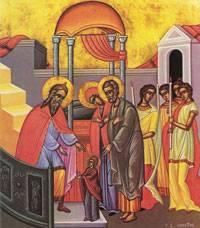
Objectives:
- Students should be able to describe the icon and tell the story.
- Students should know the date of the feast, November 21.
Possible Lesson Plan:
- Open with prayer.
- The icon: Use it to see how much the students already know? Who are the characters? (Mary, Joachim, Anna, and the high priest Zachariah).
- Review the story:
Several of the early Christian writings of Syria tell us that Mary, the
Theotokos was brought to the Temple at age three to be educated, in fulfillment of a vow made by her parents, Joachim and Anna. Remember the story of the Nativity of the Theotokos – how Joachim and Anna had prayed for the birth of their daughter? The feast was instituted in the late 4th century.
Mary and her parents approach the Temple in joy, accompanied by Mary’s small friends. Zachariah and the Temple virgins meet her in the Temple courtyard. The Temple is divided into three sections: the outer porch or courtyard, the Holy or nave where only Jews can come to pray and worship, and the Holy of Holies, behind a curtain, where only the high priest can enter, and he only once a year on the Day of Atonement. But, little Mary climbs directly up the steps and into the Holy of Holies, astounding all the people and even the angels.
Mary stayed at the Temple and grew up there, studying and worshipping. She left the Temple at about the age of 15, when she returned to Nazareth and was betrothed to Joseph.
Discussion questions: Where in the Bible is this account found? (Nowhere, but in ancient Church tradition and the Apocrypha.) Why do we believe that which is not in the Bible? (It is part of the living Tradition of the Church’s memory.) Why do Mary’s parents bring her to the Temple? If they love her so much, why give her up? (Similar situation: Hannah and Samuel in I Samuel 1:9-28)
- Have students read aloud in turn the readings for the feast:
Gospel: Luke 10:38-11:28
Epistle: Hebrews 9:1-7
Old Testament: Exodus 40:1-5, 9-11, 16, 34-35; I Kings 8:1-11; Ezekiel 43:27-44:4
- Songs of the Feast:
Troparion: Today the Virgin is the foreshadowing of the pleasure of God, and the beginning of the preaching of the salvation of mankind. Thou hast appeared in the Temple of God openly and hast gone before, preaching Christ to all. Let us shout with one thrilling voice, saying, Rejoice, O thou who art the fulfillment of the Creator’s dispensation.
Kontakion: The all-pure temple of the Savior, the most precious bridal-chamber and Virgin, the treasure-house of the glory of God, today entered the Temple of the Lord, bringing with her the grace which is in the divine Spirit: whom also the angels of God do celebrate in song; for she is the heavenly tabernacle.
- Discussion questions:
What was the importance of the Ark of the Covenant to the Jewish people? The Temple? Who built the first Temple? (Solomon)Why didn’t God allow David to build it? Who rebuilt the temple after the captivity? (Zerubabel) Who built the Temple that Mary entered? (Herod, who built a Temple to show the Jews how pious he was and to show the Romans the importance of his reign) When was the Temple destroyed and by whom? (the Romans in 70 AD, fulfilling the prophecies of Christ in Luke 19:43-44) What is now the true Temple? (the Church, the Body of Christ – I Cor. 6:19)
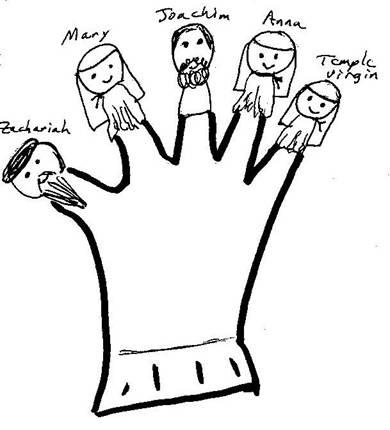 Make glove puppets to tell the story:
Make glove puppets to tell the story:
Buy some cheap gloves, even medical
ones will do although cloth is nicer.
Stuff a small cotton ball or pom-pom
in the tip of each finger and tie off,
making a head. Now decorate each
head: Mary, Joachim, Anna,
Zachariah, and a temple virgin.
Use yarn, markers, wiggly eyes,
beads, fabric, lace, felt, etc. When
the glue dries, you can tell the story
of the feast with just your own hand!
8. Make a felt banner: Buy ahead of time a piece of background color felt of your choosing (about 24x36 inches). Turn down about 1 inch at the top and staple around a coat hanger or dowel. Or use one of the pre-made banners. Have the students design a banner to illustrate the feast – its icon or its theme (the cross), etc. – with the name of the feast somewhere on it. Use the small pieces of felt to cut out figures and letters and glue on. We have felt letters with adhesive for ease in use. Hang in the Social Hall for all to enjoy! Here are a few ideas:
9. Close with prayer.
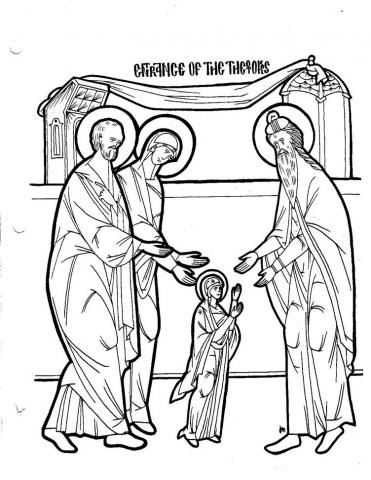
Thessalonians: Rejoice for your sake
I AND II THESSALONIANS
Scripture verse (I Thessalonians 3:9): “For what thanks can we render to God for you, for all the joy with which we rejoice for your sake before our God,”
Objectives:
- Students should understand the content and context of the verse. We'll not try to memorize this verse, but to understand it.
- Students should be able to identify at least one person who has been like Paul to them, praying for them and loving them in the Lord.
Background on the book:
Actually, if Paul’s letters were put in the order in which they were written, Galatians would be first, followed by I Thessalonians. Paul had founded the church in Thessalonica (Find it on the map, now called Saloniki.) after leaving Philippi on his 2nd missionary, during which Paul had changed his travel plans after seeing a vision of a young man in Macedonia calling out for help. Thessalonica was the leading city of Macedonia of its day, located on the Aegean Sea and on the Great Northern Highway of the Romans. Paul preached to both Jews and Gentiles, and the church there had both. After leaving Thessalonica for Athens, Paul was worried and sent Timothy back to check on the young church. When Timothy joined Paul in Corinth, Paul wrote the 1st letter to the Thessalonians, around AD 50-51.
II Thessalonians was written by Paul about a year after the first letter, probably in AD 52. Here he congratulates the believers for their continued spiritual growth and corrects a false teaching concerning the last days that had developed.
Possible Lesson Plan:
- Open with prayer.
2. Review the background of the epistle. Who wrote it? Who carried it?
- Scripture lesson: I Thessalonians 3:9:13, II Timothy 1:1-4, II Kings 2:8-14. What was Paul’s relationship to the Thessalonians, to Timothy? Was he their earthly father? In what way was he their spiritual father? How did he show his love for his children in the Lord?
- Are there examples in the Old Testament of this sort of loving father/son, mentor/student relationship: Review the stories of Moses and Joshua, Eli and Samuel, Elijah and Elisha.
- Is there someone in your own life who has had an impact on you spiritually? Does your life cause them joy? Do they pray for you? Stop right now and write a thank-you note to that person. Mail it today that their joy may be complete.
- Close with prayer.
Timothy: Genuine Faith
I AND II TIMOTHY
Scripture verse (II Timothy 1:5): “I call to remembrance the genuine faith that is in you which dwelt first in your grandmother Lois and your mother Eunice, and I am persuaded is in you also.”
Objectives:
- Students should know the “family tree” of Timothy.
- Students should know their own family tree and the importance of Christian family life.
Background on the book:
These are two of Paul’s pastoral epistles, letters to Paul’s co-worker Timothy for counsel and encouragement. Paul had met Timothy when he visited Derbe during his 1st missionary journey. Timothy was about 18 years old and became a believer. When Paul revisited Derbe on his 2nd missionary journey, he took Timothy with him as a assistant. Timothy traveled with Paul and often stayed behind to work with new believers in one area while Paul moved on to another. Timothy became a trusted and loyal friend. While the book of Acts ends around AD 63 with Paul as a prisoner in Rome under “house arrest”, it is believed that he was acquitted the first time, returned to Asia Minor and Greece, where he was re-arrested (this time by the Romans) and taken back to Rome. The first letter to Timothy was probably written in AD 64-65 from Macedonia before Paul’s second imprisonment in Rome.
By the time he wrote II Timothy around AD 66 or 67, Paul was imprisoned in Rome in a dark and damp dungeon. He knew that death by order of Nero was very near. This would be his last letter. It contains his last words of encouragement, instruction, and warning.
Possible Lesson Plan:
- Open with prayer.
- Review the background of the book. Who was Timothy? Where was he from? What was his relationship to Paul? Is there a significance that Paul wrote his very last letter to Timothy?
- Scripture Lesson: II Timothy 1:5, I Kings 15:1-3, II Kings 15:1-4, I Samuel 2:12, Luke 15:11-16. Which of these families is most like yours?
- Look at some Old Testament families: Joseph and his relationship to his father and brothers, Abraham and his relationship to his nephew Lot, David and his relationship to his son Absalom. Is the “dysfunctional family” a new phenomenon? Truly there is nothing new under the sun!
- Who were Lois and Eunice? What did we study in Colossians? Were these women famous? Was the result of their love and care, the apostle Timothy, “worth the effort” even though they never became famous in this world?
- Do you agree with this statement: “No one will influence you more than your family?” Why or why not? What is one of your favorite memories of family life? (Go around the circle on this one; this may suggest certain directions of discussion.) Why is your family together as a family? Are you getting as much from your family life as you can? How are you giving as much as you can to your family life? If you are not getting much from your family life, is there anything you can do about the situation? Is our society more concerned with the individual or with the family?
- Make a family tree for your own family. Do you remember anything about these family members?
- Close with prayer.
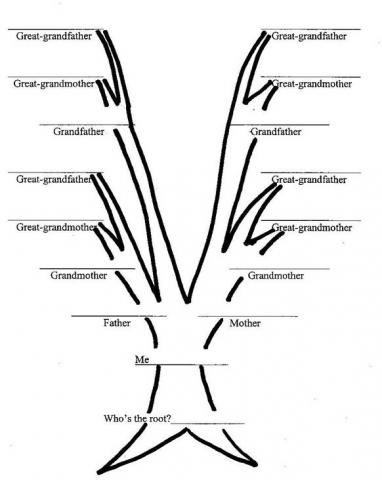
Titus: Speak, Exhort, and Rebuke
TITUS AND PHILEMON
Scripture verse (Titus 2:15): “Speak these things, exhort, and rebuke with all authority.”
Objectives:
- Students should memorize the verse and understand its content and context.
- Students should know what “exhort” means; is it the same as “nag”?
Background on the book:
Titus was a Gentile believer who traveled with the apostle Paul. He was a trusted co-worker, the one who delivered the scathing letter to the Corinthians. After Paul’s first release from imprisonment in Rome around AD 63, Titus joined Paul and Timothy in revisiting the churches of Asia Minor. After leaving Timothy in Ephesus, Titus and Paul went on the Crete. There they found a Christian Church already in existence. Where had it come from? Many think that Jews from Crete, in Jerusalem on Pentecost and receiving the gospel at that time, returned to Crete with the message. Paul and Titus taught the young believers more about the faith. Then Paul went on whileTitus remained in Crete. This letter was written by Paul to Titus before Paul’s second imprisonment, reminding him of the things he should teach the believers in Crete. Later, when Paul was imprisoned a second time in Rome, Titus was sent to Dalmatia. Titus then returned to Crete and became the first bishop of Crete.
The letter to Philemon was written by Paul during his first imprisonment in Rome around AD 61-63. Philemon was a wealthy Christian from the city of Colossae. He owned slaves, one of whom, named Onesimus, stole from Philemon and escaped to Rome. There Onesimus became a believer and knew that he must return to his master. Paul sends this letter asking Philemon to take Onesimus back and forgive him. It was written about the same time as the letters to the Colossians and the Ephesians and traveled with Tychicus and Onesimus to Colossae. Philemon would later be ordained bishop of Colossae and Onesimus bishop of Ephesus.
Possible Lesson Plan:
- Open with prayer.
- Discuss the background of the book. Who was Titus? Where have we met Titus before? (He was a trusted co-worker of Paul and had carried the first harsh letter to the Corinthians.) Why was Paul writing to him? (Titus is Paul’s letter of instruction to Titus, reminding Titus of all the things he was to teach to the believers in Crete.)
- Scripture lesson: Titus 2:15 + have the students search the book of Titus and write down any time they see the word “exhort”. This verse we will try to memorize. Print the verse and cut into individual words. Can each student put it together again? Say it together a few times.
- What does “exhort” mean? Webster’s defines it as follows: “to urge earnestly by advice, warning, etc. to do what is proper or required; to admonish strongly”. What does “nag” mean? “to annoy by continual scolding, faultfinding, complaining, urging, etc.” Review the references you found in verse 3: was Titus exhorting or nagging? What’s the difference?
- Make Joe and Sally paper bag puppets: Each student gets 2 lunch bags. One will be a boy and one a girl. Decorate them with construction paper, markers, crayons, yarn, etc., being sure that the mouth of the puppet falls at the crease in the bag. Use the puppets to do your role-playing below as a puppet show.
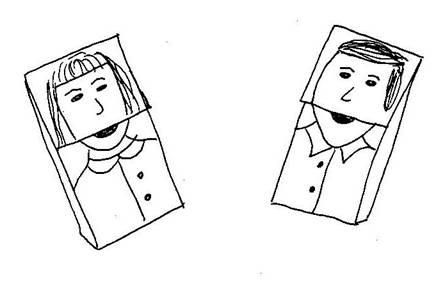
- Role-play the difference between exhorting and nagging:
Your little brother has messed up the room you share and you want it cleaned up.
You lent your favorite book to a friend and you want it returned.
You caught a Christian friend cheating on a test and you want him to confess to the teacher.
Can you think of some other situations?
7. Close with prayer.
Theophany
THEOPHANY
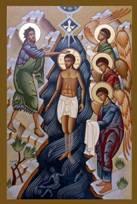
Objectives:
- Students should be able to discuss the icon, knowing each character and its role.
- Students should know the date of the feast, January 6.
- Students should be able to sing the Troparion, since they will need that for their house blessing.
Possible Lesson Plan:
- Open with prayer.
- The icon (Use this to see how much the class already knows and to retell the story.): Christ, the central figure, St. John the Baptist (why is he dressed in brown animal skin?), the angels, the Holy Spirit in the form of a dove, the river Jordan
- Scripture readings:
Gospel: Matthew 3:13-end of chapter, for Vespers Luke 3:1-18
Epistle: Titus 2:11-3:7, Romans 6:3-11
Readings on John the Baptist: his miraculous birth (Luke 1:13-41), his role as the new Elijah (Matthew 11:14, Matthew 3:3, Mark 1:3, Luke 3:4, John 1:23),
His own prophetic role in announcing Jesus (Mark 1:7-8, John 1:35-39, 3:33-35), his death (Mark 6:24-29)
Old Testament prefigurings: Genesis 1:1-3, Genesis 6:5-8:22 (the Flood (water) and the olive branch (oil)), Isaiah 1:16-18, Moses crossing the Red Sea – not actually a reading from the feast, but referred to in I Cor. 10:1-4, I Kings 18:30-39, II Kings 2:11-13
- Songs of the Feast:
Troparion: When thou, O Lord, wast baptized in the Jordan, the worship of the Trinity was made manifest. For the voice of the Father bore witness to Thee, and called Thee His beloved Son, and the Spirit in the form of a dove confirmed the truthfulness of His words; O Christ Our God who hast revealed Thyself and hast enlightened the world, Glory to Thee!
Kontakion: Today thou hast appeared to the universe, O Lord, and thy light hath been shed upon us, who praise thee with knowledge, saying, Thou hast come and appeared, O unapproachable Light.
- Discussion questions:
Who was the last and greatest prophet of Israel? (John) How were the Jewish people prepared to be “shown” the Messiah? Did John recognize Jesus when He arrived? In what ways is John the new Elijah? (Elijah’s mantle of prophecy was passed on to Elisha and from him in an uninterrupted chain of prophets, of whom John is the last)
How old was Jesus when He was baptized? How had He lived up until this time? (as an ordinary working man, a carpenter, in Nazareth) Did Jesus need to be baptized because He was a sinner? Then why was He baptized? (He was fulfilling His responsibility to represent all of creation in being cleansed.)
What does Theophany mean? (Theos meaning “God” and Phanos meaning “to show”) How was the Trinity present at Theophany? Why do we bless the water at Theophany? What do we use it for through the year? (house blessing, illness, etc.) The feast is sometimes called “Epiphany”; what does that mean? (“Manifestation”) Why was January 6 chosen for the feast? (to replace the pagan feast of the winter solstice) The Roman Church celebrates the Magi on this date; when do we honor the Magi? (December 25)
In what ways is baptism like the crossing of the Red Sea? (Pharoah, representing Satan, was wiped out just as evil is drowned forever in the waters of baptism; the column of fire protecting the people as the Holy Spirit sanctifies the waters of baptism), John baptized with what? Jesus baptized with what?
- Make a dove mobile: Using white posterboard or construction paper, cut out 4-5 bodies and 4-5 wings for each student. Allow the students to draw in eyes and color beaks on the bodies. Cut a slit through the body and slide the wings through. Decorate the wings with white feathers (found at any craft store). Grab the top of the body and see where its balance point is (this will vary, depending on decorations). Punch a hole there and add a string. Tie the strings to a coat hanger at varying lengths. If you want, you can add a sign across the coat hanger with the words the Father spoke.
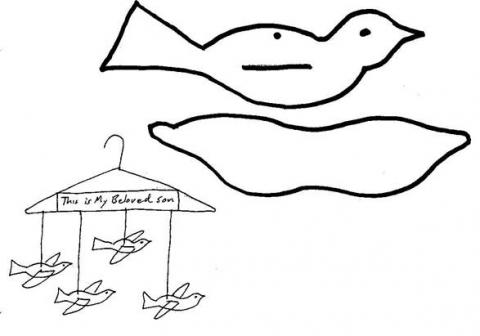
No hangers? Then print the icon background on cardstock and the icon on regular paper, color, and cut out the figures. Glue the figures in place, perhaps adding some fish, or fish stickers, or Swedish fish or goldfish crackers. Even easier? Use the colored background and colored icon, still cut out the figures, and glue them in place. Your own icon for your icon corner at home!
- Make a felt banner as before.
8. Close with prayer.
Hebrews: The Word of God
HEBREWS 4:12
Scripture verse: “For the word of God is living and powerful, and sharper than any two-edged sword, piercing even to the division of soul and spirit, and of joints and marrow, and is a discerner of the thoughts and intents of the heart.”
Objectives:
- Students should memorize the first half of the verse, and know its context and meaning.
- Students should understand that nothing is hidden from God; He cannot be fooled.
Background on the book:
Hebrews is very different from the other New Testament books in that we have no idea who wrote it. The Council at Carthage, which organized the canon of Scripture, attributed the letter to Paul; others suggest Barnabas or Apollos. It was written to Jewish believers probably from Rome before AD 70, before the destruction of Jerusalem.
Possible Lesson Plan:
- Open with prayer.
- Review the background of the book. This is the first letter we have studied possibly not written by the apostle Paul. As you look through the book, what is different in emphasis or style from the other epistles?
- Scripture lesson: Hebrews 4: 11-13, 16. Read it aloud and memorize the first half of this week’s verse. Read also Luke 8:16-17. Recite the verse a few times; this verse is quoted frequently, and the reference to the "two-edged sword" is found in literature. Take your beach ball and toss it around, with each student adding a word as he receives the ball. Be sure all have learned this important verse.
- Do Christians “mess up”? Of course. Can you think of several Bible people who also “messed up”? (Adam, Lot, David, Jonah, Peter, more?; write them on the blackboard or on a large sheet of paper, with 4 columns: name, sin, immediate result, result after repentance) Did they try to hide their sin from God? What was the result in each case? Did God find out? Can we hide from God our? Can we fool him? Should we try? As Christians, what should we do when we sin? (See verse 16) If we tell God the truth and confess our sins, how will he respond? What was the end-result in each of the cases listed? Was God faithful when they “drew near”?
|
Name |
Sin |
Immediate result |
End result |
|
Adam |
Eating from tree of knowledge of good and evil |
Thrown out of Garden of Eden |
Father of the entire human race |
|
Lot (nephew of Abraham) |
Insisting his uncle give him the best land |
Living in Sodom and Gomorrah; incest and rape |
Miraculous escape just before the destruction came |
|
David |
Stealing his friend’s wife, Bathsheba |
Death of his son, Absalom |
Birth of Solomon, who built the first Temple |
|
Jonah |
Wouldn’t go to Ninevah |
Swallowed by great fish |
City of Ninevah was saved |
|
Peter |
Denied Jesus 3 times |
Wept bitterly |
Became the rock on which the Church was built |
- How does God speak to us? Brainstorm some ways that God can speak to us “like a 2-edged sword”?
Scripture
Liturgy
Prophecy
Confession
Prayer
How should we respond when he does?
- Play hide and seek: Have everyone hide in the dark. Is it hard for “it” to find them? Turn on the lights. Now how hard is it? Let the students draw their own conclusion after a few rounds. Can we hide from God’s Word – the “Light of the world”?
- Make a "What Would Jesus Do" bracelet or necklace. Wear it!
8. Close with prayer.
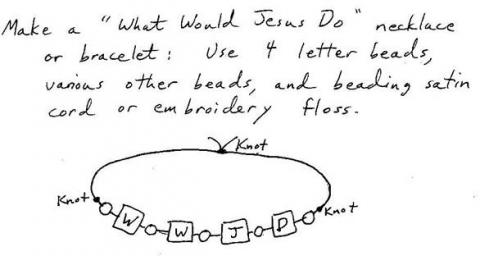
Hebrews: The Order of Melchizedek
HEBREWS 7:17
Scripture verse: “For He testifies: ‘You are a priest forever according to the order of Melchizedek.’”
Objectives:
- Memorize the verse and know who Melchizedek is.
- Understand the relationship between the Old and the New Covenants.
- Understand the comparison between the Old Testament priests and Jesus.
Possible Lesson Plan:
- Open with prayer.
- Review the background of the book. Who was writing it? (Trick question) To whom?
- Scripture lesson: Hebrews 7:17. Memorize it. Read also Hebrews 7:22-8:6. This is a long and hard passage, with big words that may need explaining. Try a memory game using the words from each of our Hebrews' verses. Print them and cut apart. Divide students into teams and see who can line up both verses correctly first.
- Discuss the law of Moses: When was it received? (Mt. Sinai) Who were the priests? (tribe of Levi, sons of Aaron) Who was to obey the law? How were sins paid for? (sacrifice) Who offered the sacrifices? (the priests) Did the priests also sin and have to sacrifice for their own sins? Is a Levitical priest permanent, or does he die like all men and have to be replaced? Were the people cleansed from sin forever, or did they have to sacrifice over and over again?
- Read the story of Abraham and Melchizedek in Genesis 14: 18-20 very carefully. Who was Melchizedek? Was he a son of Levi? How was he ordained? (by God Himself) Who gave an offering to whom – did Abraham give an offering to Melchizedek or Melchizedek to Abraham? Who is higher in rank, Abraham or Melchizedek? Does Melchizedek in the Scripture have a role other than priest? What is it? (King of Salem – which means King of Peace!) Does the Bible tell us that Melchizedek died? With what did Melchizedek bless Abraham? (bread and wine)
- How is Jesus like Melchizedek? By whom was Jesus ordained? Is Jesus also referred to as a King? With what does Jesus bless us in the Eucharist? (bread and wine become His body and blood)
- How is Jesus not like the Levite priests? Is He of the tribe of Levi? (no, Judah) Did He pay for our sins with sacrifice? Did He also sin? Does He have to sacrifice Himself over and over again? Does He live forever?
- Now you should be ready to understand how Jesus fulfilled the Old Covenant with the Jews and began a New Covenant (which was prefigured by Melchizedek and Abraham). Read Hebrews 9:14 – Do you understand it?
- Make a priest’s breastplate: Each student should be given a purple felt square about 12x12 inches. Cut 12 smaller squares out of red, blue, and gold felt. Glue the smaller squares on in rows of four. Glue a flat-backed gemstone (cheap rhinestone or large sequin) in the center of each smaller square. Cut a slit on each side and add a tie of ribbon.

- Close with prayer.
James: Wars and Fights
JAMES 4:1
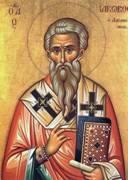 Scripture verse: “Where do wars and fights come from among you? Do they not come from your desires for pleasure that war in your members?”
Scripture verse: “Where do wars and fights come from among you? Do they not come from your desires for pleasure that war in your members?”
Objectives:
- Students should understand the verse and its context.
- Students should learn about the causes and control of anger.
Background on the book:
This book was written by James, brother of Joses, Simon, and Jude and son of Joseph (Jesus’s earthly father). He did not believe that Jesus was the Savior until after the resurrection, but later became bishop of Jerusalem and presided over the first council. He was known by his countrymen as “James the Just”. While he supported Paul in his work with the Gentiles, James, himself, was a devout Jew and worked mainly with the Jewish church. James wrote this letter to Jewish believers scattered over the world probably around AD 55-60. Later, shortly before the destruction of Jerusalem by the Roman army, James was tortured and martyred by the Sanhedrin.
Possible Lesson Plan:
- Open with prayer.
- Review the background of the book. Who was the author? To whom was it written?
- Scripture lesson: James 4:1-2, Galatians 5:19-25. Read out loud together.
- Anger is part of the human experience. Can you think of some Old Testament people who got angry and did something they later regretted? Brainstorm here: Consider Joseph’s brothers, Moses and the original tablets. What about in history – review the cause of World War I – the entire continent of Europe engulfed in war because the Austrians got angry when a Serb killed their prince. Was it worth the price?
- Have you ever felt angry? Have you just wanted to scream? Do you have a hard time controlling your anger? Why do we get angry? James gives us some answers here: our selfish desires are blamed for our anger. Did you ever get angry because you wanted to get something or have something happen and it didn’t happen? Someone had to be blamed, right? It’s easier to fight for something and demand our rights than to take the need to God in prayer. Don’t we trust God to handle it? What should we do if we don’t get our own way – get angry or get to God?
A – actions that are wrong
N – neglect of doing right
G – grief
E – energy spent in selfish ways
R – relationships that are damaged
- Read Ephesians 6:16: What is our shield against fiery darts? Doesn’t it feel sometimes like you’re on fire when you’re angry? Make an Ephesians shield from heavy cardboard or posterboard. Decorate it with paint or markers. Be sure to identify the source of your protection.
7. Close with prayer.

Meeting of the Lord
THE PRESENTATION OF JESUS
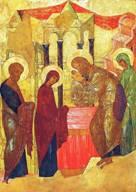
Objectives:
- Students should understand the icon of the feast and its major characters.
- Students should know the date of the feast, February 2.
- Students should understand the connection between this feast and “churching”.
- Students should be able to recite or sing St. Simeon’s prayer.
Possible Lesson Plan:
- Open with prayer.
- Present the icon; see how much the students already know: St. Joseph on the extreme left (why is he so old?), Mary the Theotokos next to Joseph, the baby Jesus, St. Simeon the God-receiver, St. Anna the Prophetess, the entrance to the Holy of Holies, the most sacred section of the Temple.
- Scripture readings:
Gospel: Luke 2: 22-40
Epistle: Hebrews 7:17
Old Testament: Exodus 13, Isaiah 6:1-12
- Songs of the Feast:
Troparion: Rejoice, O Virgin Theotokos, full of grace; for from thee arose the Sun of Justice, Christ our God, lighting those in darkness. Rejoice and be glad, O righteous elder, carrying in thine arms the Deliverer of our souls, Who granteth us resurrection.
Kontakion: Thou, O Christ God, who by thy birth didst sanctify the Virgin’s womb, and, as is meet, didst bless Simeon’s arms, and didst also come to save us; preserve thy fold in wars, and confirm them whom thou didst love; for thou alone art the Lover of mankind.
St. Simeon’s prayer (the “Nunc Dimittis”): Lord, now lettest thou thy servant depart in peace, according to thy word, for mine eyes have seen thy salvation, which thou hast prepared before the face of all peoples, a light to lighten the Gentiles, and the glory of thy people, Israel. (Sing it together!) Where does the title “Nunc Dimittis” come from? (the first 2 words in the song in Latin)
- Discussion questions:
How old was Jesus when brought to the Temple? Why was he brought? (the law of Moses – see Exodus) Who met them? Why were they there? Compare and contrast with a churching? When do we sing St. Simeon’s prayer? What is the symbolism of the passing of the child from Mary to Simeon? (maybe the encounter between Jesus and his people),
The offering of the first-born son to God is a remembrance of what Old Testament event? (Passover), Why would Jesus, the author of the Law, have to obey the Law? Why did Mary and Joseph bring 2 doves instead of a lamb? (on the surface, maybe they were too poor to afford a lamb, but symbolically Jesus is the Lamb of God; they didn’t need another lamb! If you want, review the story of Isaac; so Jesus is brought to the Temple and received by the priest right in front of the altar, a prophetic vision of his future death on the cross.)
In what way is Simeon the “last watchman” of Israel? (See Psalm 129:5-7 – Israel is now ready to share its light with all the nations), Moses was not allowed to see God face to face and Isaiah needed a coal brought by a seraphim from the altar for purification, but Simeon holds God in his arms (As the Aposticha says, “Christ once appeared to the divine Isaiah as a burning coal held by tongs. Now he is given to the elder by the hands of the Mother of God”): Why is the rule of the Old Testament now void with the birth of Christ? (God himself has come as a man and has purified us through his own power to remove all sin.)
What were the prophecies of Simeon and Anna about the Messiah? How were they fulfilled?
- Activity idea: Write a playlet; if there are “extras” they can be the dove-sellers, angels, etc. Act it out; you can make masks of paper plates if desired.
- Make a felt banner as before. Here are a few ideas:
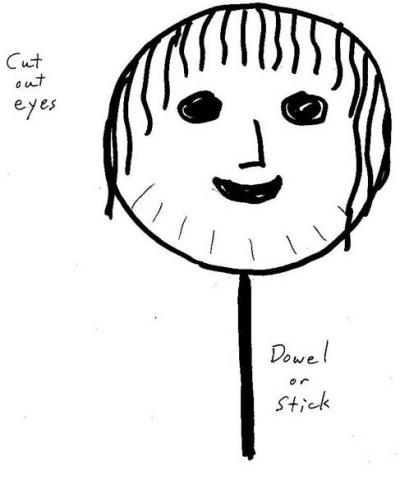
8. Close with prayer.
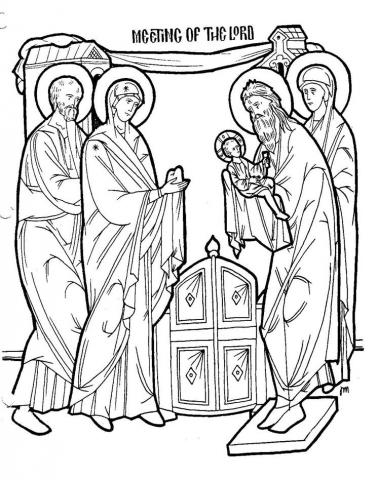
Peter: The Word of the Lord
I PETER 1:25
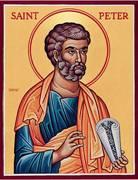
Scripture verse: “But the word of the Lord endures forever.”
Objectives:
- Students should memorize the verse and know its meaning and context.
- Students should understand the formation of the canon of Scripture.
- Students should know the meaning of “sola scriptorum” and its fallacy.
Background on the book:
This letter was written by the apostle Peter, one of the Lord’s disciples. Since Peter uses his Greek name, Peter, and not his Jewish name, Simon, we know that he is writing to Gentile believers, Greeks scattered throughout Asia Minor. Remember that Peter at Pentecost became the first leader of the church in Jerusalem. He then traveled throughout Asia Minor and ended his ministry in Rome. Peter did not speak Greek well and used Silas to help translate and write down his message. (Remember Silas from Paul’s 2nd missionary journey?) Peter wrote the letter from Rome sometime between his arrival there around AD 50 and his martyrdom AD 67 under Nero. The church was under persecution worldwide and Christians were suffering great trials. In fact, the letter may have been written immediately after the martyrdom of Paul and carried by Silas back to Asia Minor, along with news of Paul’s death.
Possible Lesson Plan:
- Open with prayer.
- Review the background of the letter. Who was Peter? Can you remember some tales about Peter in the gospels and the book of Acts? (called as a fisherman, walking on water, denial, Pentecost, vision at Joppa)
- Scripture lesson: Read I Peter 1:24-25. Read also II Peter 1:16-21, II Timothy 3:16-17. Are the Scriptures tried and tested and found to be true? Is the Bible full of mistakes, as some people claim? No one has ever been able to prove this; God’s Word has stood and will continue to stand against all the arguments raised by all the “smart” people. The Bible is true and trustworthy. Recite the entire short verse a few times to be sure the students have learned it.
- What is Scripture? Where did the books of our Bible come from? The Old Testament books were known to the Jewish people and accepted by Jesus Himself. What about the gospels and the letters? Surely many people wrote letters and Paul and Peter wrote many more that they themselves mention but are “lost”. How did the Church decide which gospels and letters to include and which to exclude? Many were of doubtful authorship; others of doubtful accuracy. The ones that remain have been accepted by the Church as authentic and accurate since the days of Constantine. Constantine himself asked the great church historian Eusebius to make 50 copies of the Bible; Eusebius by research included the same 27 books in the New Testament as are accepted today. The Council at Carthage in 397 AD established the canon of Scripture. Can you name the 27 books of the New Testament?
- What is the fallacy of the Protestant doctrine “sola Scriptorum” or “Scripture alone”? In response to misinterpretations and errors and Roman Catholic practices and doctrines that were clearly contrary to Scripture, many Protestants have decided that all doctrine and history must come only from the books of Scripture. Church history and the Church fathers who lived after New Testament days have no input or bearing and do not need to be studied. But who decided which books would be in the Bible anyway? Would there be a canon of Scripture at all had it not been for the Church fathers and councils? And what about II Peter 1:16-21? With no Church fathers to help in interpretation, doctrines can be “proven” that are clearly heretical and have been dealt with by the Church before. Does a Christian need to study and learn from the Bible? Yes, of course. Should a Christian study only the Bible and not the Church fathers and Church history?
- Make a book mark: Those new sheets of smooth foam make great bookmarks. Cut one for each student, about 2 inches by 8 inches. Cut foam pieces to decorate the front of the bookmark or buy the “foamies” (little precut pieces) and be creative. On the back, glue a list of the books of the New Testament; a table of contents right in front of you!
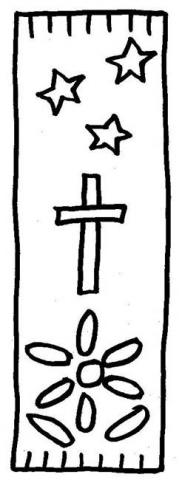
New Testament
Matthew
Mark
Luke
John
Acts
Romans
I Corinthians
II Corinthians
Galatians
Ephesians
Philippians
Colossians
I Thessalonians
II Thessalonians
I Timothy
II Timothy
Titus
Philemon
Hebrews
James
I Peter
II Peter
I John
II John
III John
Jude
Revelation
- Close with prayer.
2 Peter: Diligence
II PETER/ JUDE
Scripture verse (II Peter 1:5-7): “But also for this very reason, giving all diligence, add to your faith virtue, to virtue knowledge, to knowledge self-control, to self-control perseverance, to perseverance godliness, to godliness brotherly kindness, and to brotherly kindness love.”
Objectives:
- Memorize the verse: it’s long but important.
- Students should understand the meaning of each of the spiritual gifts listed and the need to grow into a Christian life.
Background on the books:
II Peter was written about 3 years after Peter’s first letter, probably AD 63-67. He writes to some of the same believers but also uses his Jewish name, Simon. As he wrote this letter, he was in Rome facing certain death under Nero (Do you remember how Peter was killed?).
The book of Jude was written by Jude, brother of James and son of Joseph, the earthly father of Jesus. Why was Jude (or Judas) a popular name among Jews in the first century? (Judas Maccabaeus, leader of the revolt against the Macedonian king Antiochus immortalized in the festival of Hanukkah) Jude also did not become a Christian until after the resurrection of Jesus. He wrote his letter, like that of his brother, to Jewish Christians. Jude was written about 18 years after the book of James and 27 years before the letters of John, probably AD 60-80.
These 2 books are grouped together because of similar themes, although written to different audiences. Their authorship has been well-recognized throughout Church history and the books speak of incidents involving the authors personally, but some modern scholars seem to think they may have been by the same author. How can we explain the similarity of theme without doubting their authorship?
Possible Lesson Plan:
- Open with prayer.
- Review the background of the books. Do you know the story of Hanukkah? To this day, don’t we name our children for famous or saintly people?
- Scripture lesson: Read and work on memorizing the verses. The read verses 3 and 4. Tohelp with memory work? Perhaps best to print verse in phrases on index cards, shuffle them, and have students in teams put it together again. See if each team can better its time!
- Review the physical growth of a baby? Where does it come from? What can it do at birth? At 1 year? At 3 years? At 6 years? At 10 years? At 12 years? At 18 years? Have the students brainstorm based on their own experience with younger children and siblings. Make a growth chart on the blackboard or a large piece of paper with the students’ replies.
- Have you ever wished there were a yardstick to measure spiritual growth? Well, here it is! What is the foundation? (faith) What is the first step? (goodness) What is the next step? (knowledge – Do we grow in knowledge in Church School?) Next? (self-control: let the knowledge change your actions and attitudes) Next? (perseverance: What does this mean? Why is it here? See Romans 7:19 lesson – keep at it) Next? (godliness – finally getting there – the saints exhibit this) Next? (brotherly kindness – being kind and forgiving is a good measure of how much like Jesus we are) Next? (love – now we’ve become very much like God in His love for all men) Who helps us to reach our goal? (see verse 3 – God will!) Does that mean it will be easy? Where are you now in your
 growth toward spiritual adulthood? Think of some specific events in the last few days or weeks that show evidence of one or more of the above traits. Are you growing or stagnating?
growth toward spiritual adulthood? Think of some specific events in the last few days or weeks that show evidence of one or more of the above traits. Are you growing or stagnating?
- Make a growth chart: just like we do for children as they are growing physically, so we can do as we grow spiritually.
Take a piece of poster board about 1x3 feet for each student.
Draw a “ruler” (or glue a cheap tape measure) along one side.
Add the “yardsticks for spiritual growth” along the ruler and decorate with markers, stickers, crayons, etc.
- Close with prayer.
John: From the Beginning
I, II, AND III JOHN
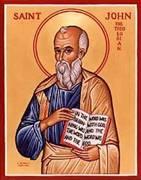 Scripture verse (I John 1:1): “That which was from the beginning, which we have heard, which we have seen with our eyes, which we have looked upon, and our hands have handled, concerning the Word of life”
Scripture verse (I John 1:1): “That which was from the beginning, which we have heard, which we have seen with our eyes, which we have looked upon, and our hands have handled, concerning the Word of life”
Objectives:
- Students should know the basis from which the Christian faith stems.
- Students should be able to point to a clear difference between the basis for Christian faith and other religions: a real, live person (Jesus) vs. somebody’s nice-sounding (all right, wonderful-sounding) ideas
Background on the book:
Each of these letters was written by the apostle John, one of the twelve disciples and the author of the Gospel of John and the Revelation. John lived in Jerusalem with Mary the Theotokos until her death, then he moved to Ephesus. Remember that John was the only one of the apostles who died a natural death at an old age, probably around 100 years old. He ended his life in exile on the island of Patmos. I John was probably written about the time John wrote his gospel, about AD 90-95. II John and III John were also probably written around the same time. It is believed that John was writing to believers in Ephesus with his first letter; the 2nd and 3rd letters are more personal notes to friends he expected to visit shortly.
Possible Lesson Plan:
- Open with prayer.
- Review the background of the book. Where have we met John in the gospels? (fisherman, Transfiguration, “the disciple whom Jesus loved”, at the cross) Find Jerusalem, Ephesus, and Patmos on the map.
- Scripture lesson: Read I John 1: 1-4, II Peter 1:16-18. What were these two apostles trying so desperately to tell their younger followers? Both were near death when they wrote these epistles and had a deep desire that the generations to come have no doubts.
- What is the “basis” of many religions today? Review Islam (the writings of one man, Mohammed), Buddhism (the teachings of Buddha), Mormonism (the teachings of Joseph Smith), Hinduism (a mystical journey through reincarnation towards “nirvana”), Confucianism (the teachings of Confucius). What do these have in common? Are there any wise teachings or sayings in the holy books of these religions? Is there any salvation in Mohammed, Buddha, Confucius, etc.? Did even they claim to be God?
- Was Jesus a wise teacher? Brainstorm for some of His wise sayings and parables. Did He make other claims for Himself? Was He a liar when He said He was the Son of God? Who knew Jesus personally, lived and traveled with him? Who was present at the Transfiguration? (Peter, James, and John) Who was present at the Resurrection? At the Ascension? At Pentecost? Who went from being frightened men, hiding out after the death of their leader, to men who were willing to die for this Lord? Would you willingly die for a lie? Do you think John and Peter were telling the truth? How is Jesus different from Mohammed, Buddha, etc.? Do we follow a set of ideas, however good, or the Son of God?
- Pretend you are a newspaper writer, documenting an important event in the life of Jesus, as witnessed by John. From an old newspaper, cut out the words and paste them on a sheet of paper to make your own “Headline Story”.
- Close with prayer.
Revelation: Four Living Creatures
THE REVELATION
Scripture Verse (Rev. 4:8): “The four living creatures, each having six wings, were full of eyes around and within. And they do not rest day or night, saying, “Holy, holy, holy, Lord God Almighty, Who was and is and is to come!”
Objectives:
- Students should memorize the verse.
- Students should understand the context of these words in the Divine Liturgy.
Background of the book:
The Revelation was written by St. John the Apostle while in exile on the island of Patmos during the fierce persecution of the Emperor Diocletian around AD 95. The early Church believed that the second coming of Jesus Christ was near, especially in these times of persecution. John is reminding them to hold fast their faith in tribulation and assuring them of the ultimate triumph of the Kingdom of God. While chapters 2 and 3 are clearly letters written to individual churches of the day, much of the book is prophetic and is full of vivid and sensational imagery. Because this book can be so easily misinterpreted (and has been in Church history), it is the only book not read publicly in the services of the Orthodox Church.
Possible Lesson Plan:
- Open with prayer.
- Review the background of the book. Find Patmos on the map.
- Read through chapters 2 and 3, assigning one church to each student:
Ephesus 2:1-7
Smyrna 2:8-11
Pergamos 2:12-17
Thyatira 2:18-29
Sardis 3:1-6
Philadelphia 3:7-13
Laodicea 3:14-22
Find those places which still exist on a map. What is the Lord’s major message to each?
- Read Revelation 4:6-11: There are Old Testament references to the four living creatures in Ezekiel (1:5,18,21) and Isaiah (6:2). Who are represented in traditional icons in the form of man, lion, calf, and eagle? (Matthew, Mark, Luke, and John).
- Look at a book of the Divine Liturgy. Read the “Cherubic Hymn”: “Let us who mystically represent the cherubim and who sing the thrice holy hymn to the life-creating Trinity now lay aside all earthly cares…” and the Trisagion Hymn: “Holy God, Holy Mighty, Holy Immortal…”, another version of the thrice holy hymn. So in Liturgy we join the heavenly liturgy of the angels. Sing both hymns if so inclined to review them with the students.
- The 4 living creatures do not rest night and day in their praise, but pray unceasingly. This is the ideal of the Orthodox Christian, approximated in many monastic communities. How can we enter into this divinely unceasing cycle of worship? How is worship different from prayer of petition? Brainstorm a list of some ways we can pray unceasingly. Are there times and places where prayer is difficult? At school? In the car? At home? At mealtime? Can prayer be included even at these times? Use today’s verse for worship. Have each student find another example of worship from chapters 4 and 5 and write it on a card. Can we remember to worship at least once an hour? Twice an hour? Why or why not?
- Make a Bible cover: Take a piece of white paper about 12x18 inches. Fold to cover Bibles of students. On the front and back, glue the faces of the 4 Evangelists from old bulletins. Then have the students draw the bodies of the four living creatures: Man for Matthew, lion for Mark, calf for Luke, and eagle for John. Write “The Bible” on the spine, along with the student’s name.
Easier? Just size the book cover to your paper with the four evangelists on the front and the four living creatures on the back. Color, and be sure the students label the living creatures.
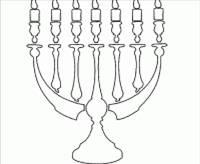 Alternate craft idea: Make ahead of time circles of paper, one of each of seven colors for each student, whole punched in the top of each. Have each student, as he prepares one of the seven churches, choose one color of circle and write on one side the name of the church and on the other a simple line drawing of something from the reading that drew his attention (like a frowny face for bad tasting). Trade “Revelation cards” among classmates so each has a complete set of seven. Tie a string thru the hole and hang from a hanger as a mobile. If you want, decorate the hanger as a 7-branched candlestand.
Alternate craft idea: Make ahead of time circles of paper, one of each of seven colors for each student, whole punched in the top of each. Have each student, as he prepares one of the seven churches, choose one color of circle and write on one side the name of the church and on the other a simple line drawing of something from the reading that drew his attention (like a frowny face for bad tasting). Trade “Revelation cards” among classmates so each has a complete set of seven. Tie a string thru the hole and hang from a hanger as a mobile. If you want, decorate the hanger as a 7-branched candlestand.
- Bring your boom box and play the last part of Handel’s “Messiah”. Where is the reference that Handel used?
- Close with prayer. Encourage students this week to join the four living creatures in praying unceasingly – or at least throughout the day.
Baptism
BAPTISM
Objectives:
- Students should know the Scriptural basis for baptism in the baptism of Jesus and Romans 6.
- Students should be able to review the order of the service and its meaning.
- Each student should be able to perform an “emergency” baptism.
Possible Lesson Plan:
- Open with prayer.
- This is the first lesson on sacraments; spend a few minutes discussing what a sacrament is: Sacraments are the means established by God to help us enter into the life of Christ. Through the Sacraments, all the benefits of salvation are imparted to us. Which is the sacrament of initiation? (Baptism) In which do we receive the gift of the Holy Spirit? (Chrismation) In which are we united with Christ and the entire Church? (Eucharist) In which is our life in Christ restored after sin? (Confession or Penance) With which does the Church establish its hierarchical unity? (Orders or Ordination) With which are we healed in soul and body? (Holy Unction) Which is a remembrance of our life on earth and our hope of the resurrection? (Requiem)
- Scriptural basis: Ezekiel 36: 25-28, I Corinthians 10:1-2, Mark 1:4, Acts 19:4, Matthew 28:19, Romans 6:3-4, I Peter 3:21, Galatians 3:27
- Order of the service (Who can remember what happens?):
|
Action |
Meaning |
|
1. We face the East. |
Light comes from the East; God gives light to our souls. |
|
2. Priest breathes on the face of the child. |
God breathed life into Adam; Baptism will breathe New Life into the soul. |
|
3. Priest’s hand on child’s head. |
Child enters the shelter of the Church. |
|
4. Exorcism: Face West.
Spit on Satan. |
Drives Satan away: West means Darkness; Satan is the Prince of Darkness. Shows our hatred of the devil. |
|
5. Profession of Faith (Creed), facing altar. |
Testify to our Faith in God, turning to Him and from Satan. |
|
6. With his hand, Priest makes a cross in the water; he then blows on the water and prays. |
All evil is driven from the water, which is made holy. |
|
7. Oil is poured on the water. |
Purifying of Baptism (water) is only possible through God’s Holy Spirit (oil). |
|
8. Anointed of parts of body with oil. |
Oil of gladness for healing, in preparation for His new life. |
|
9. Dipping 3 times in the name of the Trinity. |
All sins are washed away: buried with Christ (under water) and risen with Christ: Child dies to sin and is born again to God. |
|
10. White robe of holiness. |
Clean and pure new life in Jesus. |
- Songs of the Sacrament: As many as have been baptized into Christ have put on Christ, Alleluia! Sung in the place of the Trisagion Hymn; sing it now.
- Discussion questions:
Which of the major feasts commemorates the baptism of Jesus? (Theophany) Review the story of Theophany: Who performed the baptism? Who spoke? What did He say? Who showed himself as a dove?
Who represents the child if he is too young to speak for himself? (godparents) By what criteria would you choose the godparents of your children? How do you choose the name of your child? Why do we baptize infants? (God loves us even from the very moment of our birth.) Is baptism a divine pass to get into heaven, or must we as adults make a personal decision regarding the Christian faith?
Why is the first part of the service performed in the narthex and not in the sanctuary? (The child has not yet renounced Satan and is not yet a member of the Church.) Why do we come to the Lord naked? (Remember the Garden of Eden, before sin, when man was not ashamed of the body God had created?) Why do we use a candle in baptism? (Jesus is the light of the world.) Why do we keep the candle and use it at future feast days and our wedding? (Matthew 5:16 – Let your light so shine before men…) What Scriptural references can you think of for the use of oil in healing? (olive branch and Noah, Good Samaritan) Why are the members of our body anointed? (In baptism, not only are we cleansed from sin, but also we become useful members of Christ’s body, the Church.) Why is water so necessary for life?
 In what way does the sign of the cross, performed on our body, “brand” us as belonging to Christ? Why a triple immersion? (Several possible symbolisms: the Trinity, the days of the Lord in the tomb) Comment on the theme: “Baptism is important, but don’t hang around the river forever.” What is the meaning of the white robe? (perhaps the shining robe of Christ at the Transfiguration, since we are putting on Christ’s nature or perhaps purity as in Psalm 51 or the multitudes in white robes in Revelation 7:9-17)
In what way does the sign of the cross, performed on our body, “brand” us as belonging to Christ? Why a triple immersion? (Several possible symbolisms: the Trinity, the days of the Lord in the tomb) Comment on the theme: “Baptism is important, but don’t hang around the river forever.” What is the meaning of the white robe? (perhaps the shining robe of Christ at the Transfiguration, since we are putting on Christ’s nature or perhaps purity as in Psalm 51 or the multitudes in white robes in Revelation 7:9-17)
- Practice performing an emergency baptism (which can be done by any Orthodox Christian), complete with baby doll and cup of water (a place to immerse is unlikely in a hospital or other emergency situation):
Say: “The servant of God (name) is baptized in the name of the Father, and of the Son and of the Holy Spirit. Amen” Pour or sprinkle water on the person 3 times, once each time you say the names of the persons of the Trinity. Call a priest immediately to give the name of the newly baptized.
- Decorate a baptismal candle. Take a white colonial style candle, 10-12 inches long. Decorate with stickers, silk flowers (dig a small hole with point of scissors to receive the thick part) and leaves, ribbon, gold cross stickers, etc. Use glue sticks to attach to the candle, not Elmer’s. Have paraffin melted in a disposable metal pan. Dip once and take home.
9. Another craft idea is to make a baptism mobile. Directions are below with some sample cut-outs.
10. Close with prayer.
Baptism Mobile
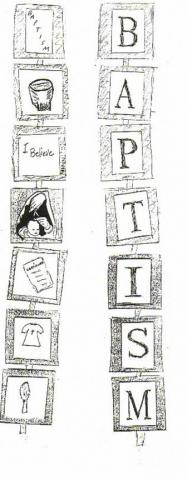 To make a baptism mobile, cut squares about 2-3 inches across from construction paper, 2 for each letter.. On one side of one set,, glue smaller white squares, each printed with one letter from the word, “baptism”. On the other set, glue smaller white squares, the top one titled “BAPTISM” and each subsequent one with a symbol or article used in the baptism. In the example on the right, there is a font, part of the creed, tonsuring, Chrismation, baptismal gown, and candle. Other ideas would be a dove, a godparent, a cross, etc., depending on your own traditions. Let the students decide which symbols they think are most important to include. Use a ribbon glued between the papers with the letters and the symbols to connect them, leaving enough at the top to tie a loop to hang the mobile.
To make a baptism mobile, cut squares about 2-3 inches across from construction paper, 2 for each letter.. On one side of one set,, glue smaller white squares, each printed with one letter from the word, “baptism”. On the other set, glue smaller white squares, the top one titled “BAPTISM” and each subsequent one with a symbol or article used in the baptism. In the example on the right, there is a font, part of the creed, tonsuring, Chrismation, baptismal gown, and candle. Other ideas would be a dove, a godparent, a cross, etc., depending on your own traditions. Let the students decide which symbols they think are most important to include. Use a ribbon glued between the papers with the letters and the symbols to connect them, leaving enough at the top to tie a loop to hang the mobile.
Chrismation
CHRISMATION
Objectives:
- Students should understand the significance of Chrismation as the gift of the Holy Spirit.
- Students should know the general order of the service and its meaning.
Possible Lesson Plan:
- Open with prayer.
- Scriptural basis: Joel 2:28, Ezekiel 36:25-27, Jeremiah 31:31-34, John 7: 37-39, John 16: 13-14, Acts 1:4-5, Acts 2:1-16, 8:14-17, 19:1-7, Ephesians 1:13-14, II Cor. 6:19-20
- Order of the service:
|
Action |
Meaning |
|
1. Anointing with holy chrism of the child’s forehead, eyes, nose, lips, ears, chest, hands, and feet |
“The Seal of the Gift of the Holy Spirit” – our entire body becomes the temple of the Holy Spirit |
|
2. Sponging off of the holy chrism. |
God’s work is now invisible, in the way we think and live and act. |
|
3. Tonsure – cutting a lock of hair in the shape of a cross |
Dedication of our whole life to God forever. |
|
4. Procession – around to baptismal font and then to the Eucharist |
The door is now open to full and complete communion with God. |
- Songs of the service: As Many as Have been Baptized… Sing it again 3 times as during the procession.
- Discussion questions:
Review where the symbolism of the oil came from (last lesson). In the Old Testament, only the prophets were filled with the Spirit; how does this differ from the New Testament? How is this expressed by the prophets? The word “chrismation” comes from what? (Greek “chrisma” meaning anointing)
Who is the Holy Spirit? How is He described? What is His role? (Helper, Comforter, Spirit of Truth, guiding us into all truth) Which of the major feasts celebrates the coming of the Holy Spirit? (Pentecost)
What is the meaning of the cutting of the hair? What does this have to do with Samson? (Hair means strength; the child gives God all his strength)
Now that we are filled with the Holy Spirit, how should our lives be changed? What is the fruit of the Spirit? (Galatians) Do we exhibit the life of the Spirit in our everyday life?
- Do a Chrismation Relay Race: Divide the class into 2 teams. Place 2 chairs at the end of the room, each containing a tiny bowl of olive oil (NOT blessed oil), a damp sponge, a ball of yarn, and a scissors. First player runs to the chair, dips his finger in the oil and grabs the sponge, runs back and makes a cross on the forehead of the next player and wipes it off while yelling “Seal!”, runs back to the chair, snips a piece of yarn and races around the chair 3 times singing “As Many as Have Been Baptized”. He then runs back and tags the next player. Team finished first wins; perhaps a prize (cheap)?
- Make a Chrismation mobile, like your Baptism Mobile: To make the mobile, cut squares about 2-3 inches across from construction paper, 2 for each letter.. On one side of one set,, glue smaller white squares, each printed with one letter from the word, “BAPTISM”. On the other set, glue smaller white squares, the top one titled “CHRISMATION” and each subsequent one with a symbol or article used in the Chrismation service. Some ideas would be a font, holy oil, cotton, sponge, icon of Pentecost, dove, flame, etc., depending on your own traditions. Let the students decide which symbols they think are most important to include. Use a ribbon glued between the papers with the letters and the symbols to connect them, leaving enough at the top to tie a loop to hang the mobile.
- Close with prayer.

Annunciation
THE ANNUNCIATION
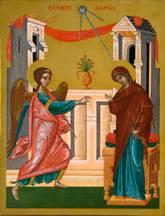
Objectives:
- Students should be able to identify the characters in the icon and tell the story.
- Students should know the date of the feast, March 25
- Students should know that Mary is the Theotokos and what that means.
Possible Lesson Plan:
- Open with prayer.
- Review the icon: See how much the students already know. There are only two participants, Mary and the Archangel Gabriel. Mary carries a spool of yarn, Why? Because just as sheep give their wool to clothe humanity, Mary gave her body to clothe the eternal Son of God in a garment of humanity. What’s on the scroll in the center? Whose prophecy does it depict? (Isaiah)
- Scripture readings:
Gospel: Luke 1: 24-38 (also read 6-55)
Epistle: Hebrews 9:1-7
Old Testament: Genesis 28:11-17, Ezekiel 43:27 and 44:14, Proverbs 9:1-11
- Songs of the feast:
Troparion: Today is the beginning of our salvation, and the manifestation of the mystery from the ages; for the Son of God becometh the son of the Virgin, and Gabriel proclaimeth grace. Wherefore, do we shout with him to the Theotokos, Hail, O full of grace, the Lord is with Thee.
Kontakion: Verily, I, thy city, O Theotokos, inscribe to thee the banners of conquest, O defending soldier, and offer thee thanks as a deliverer from tribulations. And since thine is the unconquerable might, deliver me from sundry oppressions, that I may cry unto thee, Rejoice, O groomless bride.
Prosomia of vespers: Then the bodiless Angel replied: when God so wishes the order of nature is overcome, and what is beyond man comes to pass, believe that my sayings are true, O All-Holy Lady, utterly without spot. And she cried aloud: Let it be to me according to your word, and I shall bear Him that is without flesh, Who shall borrow flesh from me, that through this mingling He may lead man up to His ancient glory.
Oikos of matins: Hail, restoration of fallen Adam:
Hail, consolation of Eve…
Hail, you through whom creation is renewed;
Hail, for through you the Creator becomes a newborn child.
Hail, you Bride unwedded.
- Discussion questions:
What is a mother? Role? Why did Jesus, God Himself, need a mother? (One cannot be born without one!) Who is the Mother of God? What do we call her? What does “Theotokos” mean?
What word does “annunciation” come from? (“announce”) What is announced? Who does the announcing? From Whom does the message come? Where is the announcement made? Is Mary free to make a choice to accept or not accept what God wishes from her? Would you have accepted and why or why not?
What is the Incarnation? (God taking flesh) In what way was it not only the work of the power of God, but also the work and will and faith of the virgin Mary? This is called the “Fiat” – in Latin “so be it” – the union between the wills of the 3 persons of the Trinity (How was each involved?) and with humanity through the agreement of Mary. Why is Annunciation exactly 9 months before Christmas? Students may want to discuss their own mothers’ pregnancies with a younger sibling, etc.
What is the relationship between Mary and Elizabeth, the mother of John the Baptist? How long had Elizabeth been pregnant when the Annunciation occurred? Compare and contrast the responses of Mary and of Zachariah when each heard from the angel. What is the Magnificat? (Luke 1:46-55) What are the circumstances where Mary sings this great song of praise and thanksgiving? (She’s visiting Elizabeth) What is the Rosary, spoken by Roman Catholics the world over and where does it come from? (Hail, Mary, full of grace, the Lord is with thee, blessed art thou among women and blessed is the fruit of thy womb, Jesus)
What does the burning bush (reading from Exodus) have to do with the Annunciation? (the bush was filled with God and not consumed, so was Mary) How is Mary the restoration of Adam and the consolation of Eve? (Genesis reading)
- Make a felt banner as before. Here are a few ideas:
- Make an “Icon Theater”: Cut the 2 characters out of the icon and color. Tape or glue each to a Popsicle stick. Take a cereal box for each student. Cover it with construction paper. Cut a “screen” out of the front and a slit in the side to allow the puppets to enter. Decorate a sheet of white paper like the background of the icon and glue onto the inside of the back of the box. Tell the story.
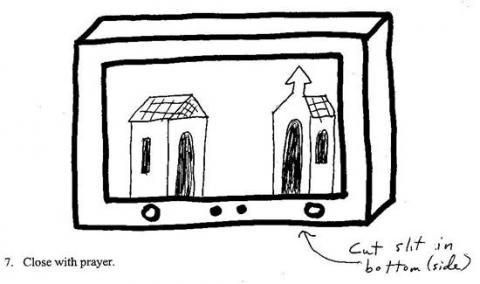
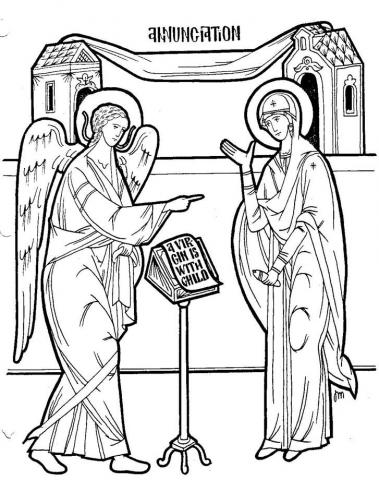
Confession
- CONFESSION
Objectives:
- Students should understand the origin of confession and its meaning.
- Students should know how to prepare for confession.
Possible Lesson Plan:
- Open with prayer.
- Scriptural basis: 2 Samuel 11:1-12:13, Psalm 51, I John 1:9, Matthew 18: 17, James 5:16, John 20:23, Matthew 16:19, John 8:11
- Order of the service:
|
Actions |
Meaning |
|
1. Preparation: Trisagion, O Heavenly King, Psalms 23, 24, 116:10-19 |
We prepare to return to the Lord. Review the story of the Prodigal Son – Luke 15. |
|
2. We confess our sins in the presence of our priest. |
We act in obedience to Christ. Review the story of the Publican and the Pharisee – Luke 18:10-14 |
|
3. We receive forgiveness of our sins when the priest places his stole on our heads and prays to God to forgive us. |
God promises to forgive us if we confess our sins; there is rejoicing in heaven – Luke 15:3-7; why does the priest compare himself to Nathan the prophet? |
- Discussion questions:
In preparation for Confession, what are some questions we can ask ourselves? Let the students try to come up with some of their own. Then ask them some of these: How have I behaved towards God (Did I pray daily? Did I thank Him? Have I used His name in vain?) How have I behaved towards my family and friends? (Have I prayed for them? Have I been loving, honest, and respectful or have I lied and been unkind and disobedient? Have I shared with my brothers and sisters or been selfish? Have I helped at home, at school, etc.? Have I cheated or been lazy in my schoolwork? Have I made fun of anyone?) How have I behaved towards myself? (Have I been responsible? Have I cared for my body?) Am I truly sorry for my sins and really want to change my habits?
Why can’t we just confess in secret to God? (What about that pervasive self-deceiving psychological trick, denial, and accountability?) Who does the priest represent? (Christ) Did Jesus have the authority to forgive sin? (Consider the healing of the paralytic and the woman caught in adultery.) What was the practice of the earliest Christians? (They actually stood up before the whole congregation and confessed their sins, truly walking in the light.) Why did this practice end and priests begin to hear confession privately? (Strangers coming to visit as the Church grew in numbers made public confession difficult.)
- Make a Prodigal Son movie: Take an envelope and cut out a screen about 5 inches long on one side. Seal it and cut off both ends. Take a long piece of paper (about 36 inches) just wide enough to fit through the envelope. Divide the strip of paper, comic-book style, into sections just large enough for the “screen”. Have the children illustrate one scene from the movie in each screen (first and last ones blank) – for example, son leaves home with money, son spends money, son living with pigs, son returns to father, big party. Insert through the envelope through the envelope and pull along, telling the story.
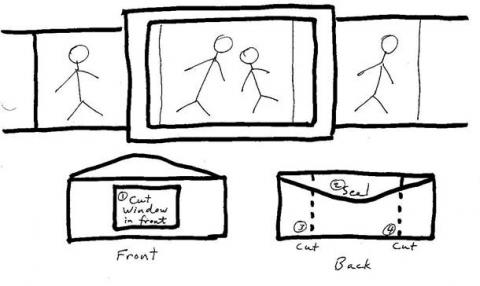
- Close with prayer.
Palm Sunday
PALM SUNDAY
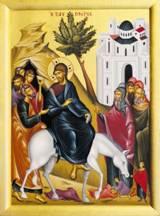
Objectives:
- Students should be able to identify the characters and the action in the icon.
- Students should know why we use palms on Palm Sunday.
- Students should know that Palm Sunday is the day after Lazarus Saturday and the week before Pascha. Why?
Possible Lesson Plan:
- Open with prayer.
- The icon: What do the students already know? Christ the central figure, seated on a donkey (Why a donkey?), the disciples on the far left and the Jews on the far right, the children (one in a tree cutting palm branches and one spreading his cloak under Christ), the city of Jerusalem with the Temple with its onion dome.
- Scripture readings:
Gospel: Matthew 21:1-11, 15-17, John 12:1-18 (also for Lazarus John 11:1-45)
Epistle: Philippians 4:4-9
Old Testament: Genesis 49: 1-12, Zephaniah 3:14-19, Zechariah 9:9-15
- Songs of the Feast:
Troparion: By raising Lazarus from the dead before thy passion, thou didst confirm the universal resurrection, O Christ God. Like the children with the palms of victory, we cry out to thee, O Vanquisher of death: Hosanna in the highest, Blessed is He that comes in the name of the Lord.
Kontakion: Upborne upon the heavenly throne, and seated upon the earthly foal, O Christ our God, receive the praises of angels and the hymns of men, exclaiming before thee, Blessed is He that cometh to restore Adam.
- Discussion questions:
When did Jesus hear about Lazarus’s illness? What did he do? What do we celebrate on Lazarus Saturday? What happened? Who were the major characters? Was this the first person Jesus raised from the dead? (No, the son of the widow of Nain and the daughter of Jairus, but both had just died; they had not been dead for 4 days) Why is the 4 days important; why did Lazarus “already smell”? (The 4 days show true corruption, the rottenness inside us all, defeated by Jesus in the tomb, since He alone is without corruption or sin) Who did Jesus say that He was to Martha? (I am the resurrection…)
What’s the shortest verse in the Bible? (piece of trivia, “Jesus wept.” Why did Jesus weep? (because God truly cares, He is the Lover of Mankind) How did the resurrection of Lazarus effect the response of the crowd on Palm Sunday? Explain the Troparion in your own words; the same Troparion is used for Lazarus Saturday and Palm Sunday, why? What did Jesus show the world? (that God’s power is greater than death) Did Jesus enter Jerusalem on a warhorse surrounded with an army? Why not? (He came to bring His love, coming on a peaceful donkey) What was the significance of the donkey? Whose prophecy was being fulfilled? (Zechariah) How’d he get the donkey?
What does “Hosanna” mean? (“I ask you to save me”) Where did the greeting the people gave Jesus on Palm Sunday come from? (Psalm 118: 25-26) Thus Jesus is being recognized as King. What is the significance of the greeting, “Son of David”? (Jesus is recognized as Messiah.) Did Jesus sneak into the city, afraid of its leaders since He know what they would do to him only a few days later? What would you have done in that situation? Does the raising of Lazarus and the triumphal entry into Jerusalem have any effect on the priests who will later condemn Jesus? (It is because of these and the response of the people, that He was judged and condemned.) What is the significance on Palm Sunday of Jesus’s reddish garments? (From Genesis 49: represent blood) Remember that with our palms of joy we are also called to suffering and death; we cannot have the one without the other!
- How does our Church celebrate Palm Sunday? What is the significance of these customs?
- Make a flannel story board: Take a pizza box (Pizza shops will usually give you a few for free if you tell them what it’s for.) for each student. Cover the back with light blue flannel. Decorate with palm trees and background buildings with markers or felt. Glue the icon coloring page to a piece of felt. Cut out the figures and color. Use to tell the story to younger children.
6. Can't get pizza boxes? Use a paper plate, fold in half, and color bottom green with a road, and top with scenery. Cut a slit for the puppets to enter between the "ground" and the "sky" almost across the plate, leaving the rim intact. Print icon or coloring icon on cardstock. Cut out the figures from the icon and color them, tape popsicle sticks or pipe cleaners to their backs, and you have a puppet theater to tell the story. Set your "theater" on the edge of a table and stand behind it to have puppets enter through the slit.
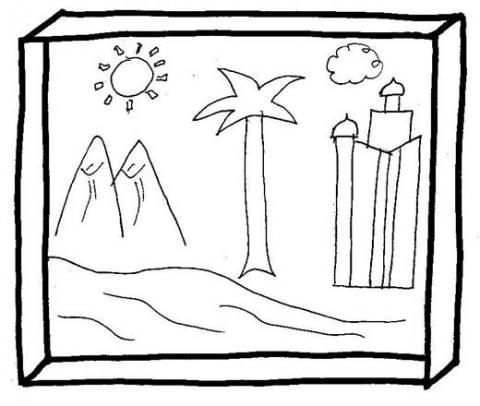
7. Too involved on such a busy day? Make a cross from the palms from church: Take the long skinny palm leaf and fold the thick end down the length that you want your final cross to be. Now fold the long end down the back to where the crosspiece should lie and fold sideways at a 45 degree angle the length of one arm of the cross. Fold it across to make the other arm of the cross and back to the back. Then wrap the short end in figure X around the center to hold the entire cross together and tuck the final end into the back.
8. Make a felt banner as before. Here are a few ideas:
9. Close with prayer.
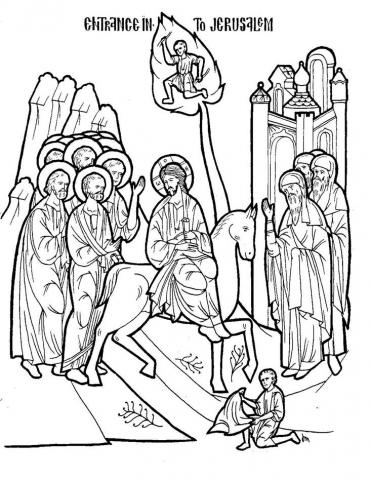
Pascha
PASCHA, THE FEAST OF FEASTS
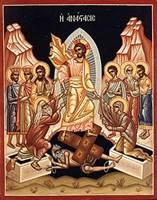 Objectives:
Objectives:
- Students should understand the icon, its characters and its significance.
- Students should know the Troparion of the feast and “Christ is risen…”
- Students should know the Paschal greeting and response, preferably in several languages.
Possible Lesson Plan:
- Open with prayer.
2. The icon: again begin with its review and discussion. Christ is the central figure, robed in white (Why?) surrounded by light (Why?), at His feet are the brass gates of Hades, the keys, and the locks that He destroyed. Adam is being pulled from his tomb by Christ with His right hand and Eve with His left. The righteous from the Old Testament gather on the left; the 2 in the front are Kings David and Solomon. The righteous from the New Testament are those on the right, those who died after the Incarnation and before the resurrection; in front we find St. John the Baptist and St. Joseph.
3. Scripture readings:
Gospel: John 1:1-17, Matthew 28
Epistle: Acts 1:1-8, Romans 6:3-11
Old Testament: Ezekiel 37:1-14, Exodus 12:1-11, Daniel 3:1-88, review the story of Jonah
- Songs of the Feast:
Troparion: Thy resurrection, O Christ our Savior, the angels in heaven sing, enable us on earth to glorify thee in purity of heart.
Another Troparion: Christ is risen from the dead, trampling down death by death, and upon those in the tombs bestowing life!
Kontakion: Though thou, O deathless One, didst descend into the grave, thou didst destroy the power of hell and, as victor, thou didst rise again, O Christ our God. Thou didst greet the ointment-bearing women, saying, Rejoice! Thou didst bestow peace upon thy Disciples, and resurrection upon those that are fallen.
Megalynarion: The angel cried to the Lady full of grace, Rejoice, O pure Virgin. Again I say: Rejoice. Your Son is risen from his three days in the tomb. With himself he has raised all the dead. Rejoice, all ye people. Shine! Shine! O new Jerusalem! The glory of the Lord has shone on you. Exult now and be glad, O Zion! Be radiant, O pure Theotokos, in the resurrection of your Son.
- Review the chronology of Holy Week (put the events on cards and have the students place them on a time line?) and the major players:
Jesus, the 12 disciples (who were they?), myrrh-bearing women (though they haven’t brought the myrrh year, who will they be?), the Pharisees (a group of religious leaders of the Jews particularly devoted to the Torah), the Sadducees (a wealthy priestly aristocracy, concerned with Temple administration and ritual), the scribes (educated civil servants), the Sanhedrin (a senate of 70 priests and laymen, presided over by the high priest), Caiaphas the High Priest, Pontius Pilate the Roman governor, Herod the King, Barabbas the condemned murderer, the 2 thieves, the centurion (the same one who had early sough Jesus out for healing of his servant according to tradition), and Joseph of Arimathea (a wealthy follower of Jesus and member of the Sanhedrin, “the noble Joseph”).
Holy Monday: Teaching in the temple (parable of the wedding banquet), questioned by the priests: Some sample questions were “By whose authority are You doing these things?” and “Is it lawful to pay taxes to Caesar?” Read in Matthew 21 and 22 Jesus’s clever answers.
Holy Tuesday: teaching again, many parables about the kingdom, including the talents, the foolish virgins, the sheep and goats at the Last Judgment.
Holy Wednesday: Anointing of Jesus at the home of Simon the leper (therefore the church custom of anointing with oil this evening) and betrayal by Judas Iscariot to the chief priests for 30 pieces of silver.
Holy Thursday: Arrangements for the upper room, washing of the disciples’ feet, the Last Supper, the prayer in the Garden of Gethsemane, the betrayal by a kiss in the garden, the trial before the Sanhedrin. How do we celebrate Holy Thursday? Why the last Eucharist (before Pascha)? Listen closely to the 12 gospel readings on Holy Thursday night; they tell the entire story of Holy Week.
Great and Holy Friday: denial by Peter, suicide by hanging of Judas, trials before Pilate, Herod, and Pilate, crucifixion, and burial by the noble Joseph of Arimathea. What did Jesus say from the cross? (You’ll have to look in all of the Gospels to find all the sayings.) How do we celebrate Holy Friday? Why the bier and funeral procession?
Great and Holy Saturday: Descent into Hades and victory over death! Why are the vestments, candles, and altar pieces changed to white?
Pascha: Resurrection! The Church is in darkness. Light spreads to all from the Trikirion, the 3 in 1 candle representing the Trinity. We process around the church like the myrrh-bearing women walking to the tomb. Eggs represent new life. We greet each other with:
English: Christ is risen! Indeed He is risen!
Greek: Christos anesti! Alethos anesti!
Russian: Christos voskrese! Voistinu voskrese!
Arabic: Al-masi-kam! Haq an qaam!
Romanian: Christos inviat! Adeverat inviat!
6. Discussion questions:
Why is the resurrection considered the central truth of Christianity? (Read I Cor. 15:13-19) How is this different from other religions? Was the resurrection a hoax perpetrated by the disciples? (Would each of them later die for what they knew to be a lie?) Or did the authorities move the body? (But why didn’t they then display it to the public when the disciples claimed He had risen and thus prove He was still dead?) Or did Jesus never actually die at all, but just faint? (All contemporary accounts, even those of the Jewish and Roman authorities of the time, agree that He most certainly died.) Did the apostles all have identical “hallucinations” after His death of His appearances? (Be realistic – all 500 who saw Him at 10 distinct times and places! Can you identify some of His appearances – e.g. upper room, Sea of Galilee, road to Emmaeus, Ascension, etc? What about doubting Thomas? Hallucinations usually involve seeing things one really wants to see, not being convinced against one’s will!)
What Old Testament characters/stories are referenced in the canon and why? (“the inspired prophet Habakkuk”, “David the ancester of God leaped and danced before the ark which prefigured thee”, “like Jonah from the whale on the third day you arose from the grave”, “resurrecting Adam the father of us all”, “He who saved the three young men from the furnace became incarnate and suffered as a mortal man”)
Whose homily is always read? (St. John Chrysostom) What is its theme? (Review the parable of the laborers in the vineyard; did those who arrived on the first hour receive a better reward than those who arrived at the eleventh hour? “O death where is thy sting? O Hades, where is thy victory? Christ is risen and thou art annihilated…”)
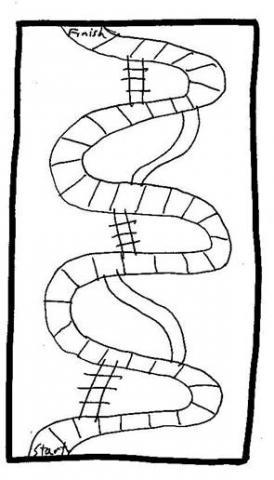
- Make a Holy Week Game: Each student
should get a piece of poster board about
12x24 inches. Ahead of time, draw on
each board a zigzag pathway like in
“Snakes and Ladders”. Have students
write the incidents of Holy Week,
beginning with Palm Sunday, on the
board; good events (like Palm Sunday
and the Last Supper) get a ladder (Who
in the Bible saw a ladder to heaven?),
while sad events get a snake (Who does
the snake represent?) Play the game,
if there’s time, or take it home to play
with parents and siblings.
- Make a felt banner as before. Here are some ideas:
- Close with prayer.
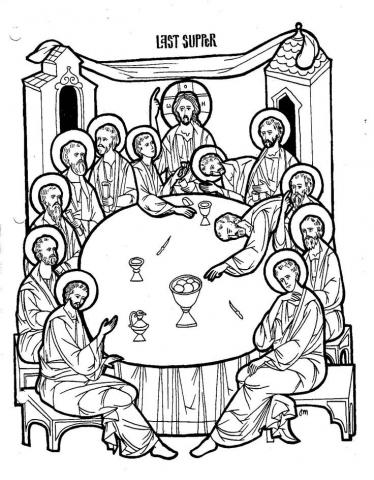
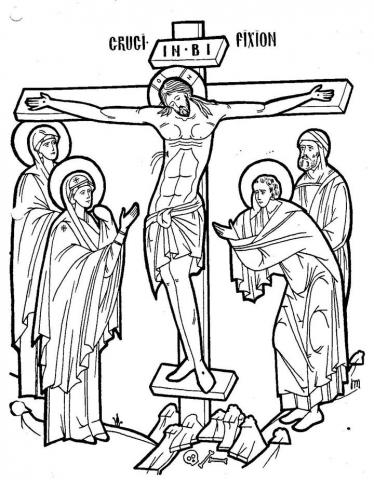
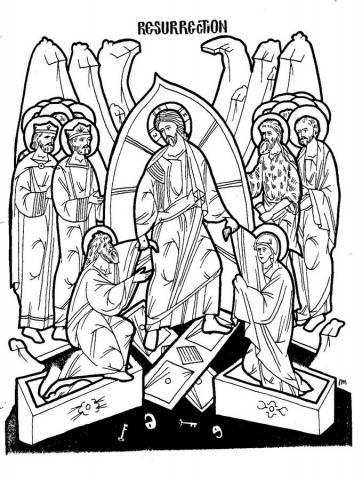
Divine Liturgy
THE DIVINE LITURGY AND EUCHARIST
Objectives:
- Students should understand the Scriptural basis for and spiritual significance of the Eucharist.
- Students should know the order of worship of the Divine Liturgy and understand the meaning behind the actions.
- Students should know the name and purpose of the major liturgical pieces.
Possible Lesson Plan:
- Open with prayer.
- Scripture lesson: Luke 22:19-20, Acts 20:7, I Cor. 11:23-30 – Why do we celebrate the Eucharist? Are they truly His body and blood or only a symbol? How do they become His body and blood? (a mystery!) What can happen if they are taken unworthily?
- Order of the service (We’ve all gone every week to liturgy; try making some cards and see if the students can put them in order!):
|
Action |
Meaning |
|
Proskomedia (Preparation): The priest pours the wine and cuts the bread (pros-phora) into small pieces and places them on a golden plate called the diskos, a large piece representing Jesus in the center, a piece for Mary to the right, 9 pieces for the saints to the left and rows below them for those living and dead. |
The entire Church is gathered on the plate and prayed for during the preparation. |
|
“Blessed is the Kingdom”: the priest opens the Royal Doors and stands with raised hands before the altar. |
We are all invited to a celebration, a journey to God’s kingdom not unlike the journey of the Hebrew people from Egypt to the Promised Land. |
|
Litany: The priest leads us in prayer, saying after each prayer “Let us pray to the Lord” and we respond “Lord, have mercy” or “Grant it, O Lord”. |
We pray for all of the world’s needs: for peace, the Church, the nations, good weather, food, travelers, the sick, prisoners, safety, etc. |
|
Antiphons, Troparia, and Kontakia. |
We give praise to God in the antiphons, originally sung by 2 choirs antiphonally. The Troparia and Kontakia – the “theme songs” of the day or season. What is our parish’s “theme song”? Beginning with Pascha, we sing Tone 1 the first Sunday, Tone 2 the 2nd, etc. and then repeat. |
|
The Emperor’s Song: “Only begotten Son and immortal Word of God” |
Written by the Emperor Justinian in the 6th century, he was a good and just ruler who wanted to say in a very few words a summation of what the Bible teaches about Jesus Christ. |
|
The “Little” Entrance: The priest, preceded by altar boys carrying lighted candles, carries the Gospel book, showing it to all the people and then placing it on the altar table. |
The Gospel contains the writings of 4 of the apostles about Jesus Christ. Which 4? It guides us in our journey towards the kingdom of God. What are some other times we make a procession? |
|
Trisagion: We prepare to hear the word of God by singing the song that the angels sing, “Holy God!…” |
The “three holies” remind us of the Trinity--Father, Son, and Holy Spirit. |
|
Prokimenon (short verses from the Old Testament), Epistle, Gospel readings. |
The Old Testament verses remind us that God’s prophecies were fulfilled in Jesus Christ. Epistle and Gospel follow a theme begun with the Psalm. |
|
Great Entrance: While the choir sings “Let us who mystically represent the cherubim…”, the priest, again preceded by the altar boys with lighted candles, brings our gifts of bread and wine and places them on the altar. |
We give gifts to someone we love. Bread and wine are our gifts, which God will give back to us as Holy Communion. The procession symbolizes the Via Dolorosa, the walk of Jesus to the Cross, to which we also are called. |
|
Creed: We all recite the creed together. |
We reaffirm our faith in God. |
|
Anaphora: The priest offers our gifts to God and we give thanks to God. We sing the “Angels Hymn” (“Holy, holy, holy…”) just as the angels sing in heaven. |
“Anaphora” means “lifting up” in Greek: here we offer not only the bread and wine but all of our lives and the entire world to God, because this is His right. We remember that we are not the only ones who serve God. |
|
Prayer of Thanksgiving: The priest reminds us of all that Jesus has done for us on the cross and asks the Holy Spirit to bless our gifts and make them the body and blood of Jesus Christ. |
God sends His Holy Spirit and our simple gifts of bread and wine become Christ’s own body and blood. We praise and thank God for this great mystery. |
|
Megalynarion: We sing a song remembering Mary the Theotokos. |
Mary, the Mother of God, was especially close to Jesus and the Bible commands us to honor her. Do we worship her? |
|
Lord’s Prayer: We pray the prayer that Jesus commanded us to pray. |
Only through Jesus have we the right to call God “father”. |
|
The Eucharist: We all line up and receive the body and blood of Christ, “in the fear of God with faith and love draw near”. |
Jesus invites us to His table in His kingdom. |
|
Benediction: We sing “We have seen the true light, we have received the heavenly Spirit, we have found the true faith” and the priests leaves the Sanctuary and goes to the center of the Church where he thanks God and asks God to give us His peace. The priest then blesses the people with the cross, receiving a piece of bread. |
Our journey is at an end. His kingdom now lives in us. What does this mean? How should we conduct our lives as citizens of a heavenly kingdom? How did the apostles conduct their lives? |
4. In the sanctuary or with pictures, identify these articles:
Sanctuary (altar) at the eastern end of the church, why?
Iconostasis: icon screen
Corporal with Antimins: Altar covering used only during communion and
containing relics of the saints
Seven-branched candelabra
Tabernacle (or Ark), where are kept the Communion for the sick and for the
Presanctified liturgy
Gospel Book
Sacramental Fans, representing the Seraphim
Table of Oblation, where the priest prepares the Holy Gifts
Diskos (or Paten): a plate for the bread
Star Cover: to support the veil so it does not touch the bread
Chalice: cup for the wine
Spoon and Sponge and Spear: the spear is used to cut the pieces from the
Prosphora, the spoon to give Communion, and the Sponge to clean
Veils: Covering for chalice and paten
Censer, for incense
5. Discussion questions: Likely the above discussion will take most of the class
 time. Most important would be to discuss the various parts of the liturgy and meaning.
time. Most important would be to discuss the various parts of the liturgy and meaning.
- Make a censer: Take an empty tin can for each student. Remove the top and clean.
Freeze full of water overnight and bring to church frozen. Bring hammers and nails.
Have the student mark with marker a design on the outside of his can in dots. Then use the nail and hammer to punch a hole at each dot. Punch 3 holes at the top for hanging strings or wires. Dump out the ice (probably soft now anyway) and tie on hanging strings.
Knot strings at top. You can use this for incense or for a candle. Can you swing it like Father does? It’s harder than it looks!
7. Alternate craft: Make a Proskomedia Plate. See below for directions.
Really love paper crafts: Do the diorama of the entire church provided by ByziMom.
8. Close with prayer.
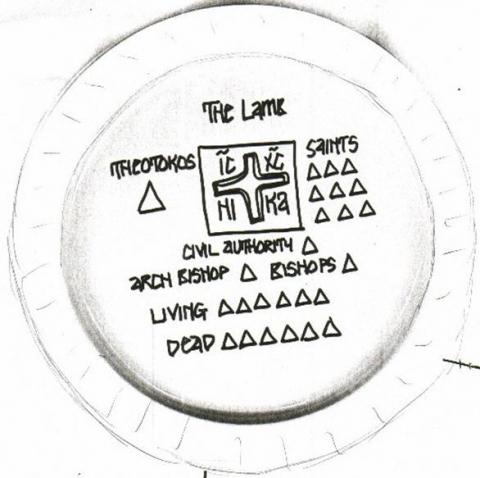
Proskomedia plate: Take a small paper plate for each student. Copy the circle above and cut out; glue into center of plate. Give each student a lump of play dough; stamp with seal if desired. Have each student divide his proskomedia play dough just as the priest does at the beginning of Liturgy; have your priest or deacon as a guest speaker if desired. Make lists of the living and dead of each student’s family to pray for. Review the meaning of each division of the proskomedia.
Print the pages to start your diorama thanks to ByziMom. What a wonderful addition to your classroom! You can draw your own to look like your own parish. One easy way is to print the outline and then, taking a photo of your own iconostasis, substitute your own icons. The figures of the people, priest and deacon, can be cut smaller or larger to fit your dioramas.
Marriage
MARRIAGE
Objectives:
- Students should know the Scriptural pattern for marriage.
- Students should know the structure of the marriage ceremony and the meaning of each part.
Possible Lesson Plan:
1. Open with prayer.
2. Scriptural references: Genesis 1:28, 2:20-24, Genesis 12:1-5, Genesis 24, Luke 1:5-58, Ephesians 5:20-33, John 2:1-12, Revelation 19:7-9
- What liturgical items are used in an Orthodox wedding? Brainstorm what the
children have seen and what these things might mean?
Two white candles – symbolizing the light of Christ
Rings (A picture of two rings will suffice.) – a circle that never ends
The crowns: either wreaths, (Greek tradition) or gold crowns
(Slavic tradition) – king and queen of a new home
The Gospel book – ordained by God in His Word
The common cup – This new home is part of the whole Church
Hand cross used by the priest – Christ is the center of the marriage
- The Sacrament of Holy Matrimony is the sacrament of the family. What is the order of that sacrament?
|
Action |
Meaning |
|
1. Betrothal: The “natural” marriage at the vestibule of the Church when the husband and wife promise themselves to each other and rings are exchanged. |
This takes place in the narthex since it is a worldly promise, but blessed by the priest, saying, “The servant of God (name) is betrothed to the handmaid of God (name) in the name of the Father, and of the Son, and of the Holy Spirit, Amen.” |
|
2. Crowning: Special prayers remembering couples who have obeyed God, families in the genealogy of Jesus, and blessing this new family. He then places a crown on each head, saying, “The servant of God (name) is crowned unto the handmaid of God (name) in the name of the Father and of the Son and of the Holy Spirit.” |
The crowns are a sign of the glory of God’s kingdom, and the bride and groom are crowned as king and queen of their own little kingdom, into which later children will be citizens. The crowns have 3 meanings; King and Queen of Creation Martyrdom Crowns of the Kingdom |
|
3. Prokimenon: Thou has set upon their heads crowns of precious stones; they asked life of Thee, and Thou gavest it them.” |
We are called to rule well in our own little kingdom. |
|
4. Epistle: Ephesians 5:20-33 |
Each marriage should mirror the way Christ loved the Church. |
|
5. Gospel: John 2:1-12 |
As at the wedding at Cana, the only real joy is given through Jesus Christ. |
|
6. Common Cup: Bride and groom drink wine from a common cup |
Originally this was Holy Communion, a real sign of union in Jesus Christ |
|
7. Procession: The priest leads the bride and groom 3 times around the center table, while the people sing 3 hymns: “Rejoice, O Isaiah! A Virgin is with child…”, “O holy Martyrs, who fought the good fight and have received your crowns…”, and “Glory to Thee, O Christ God, the apostle’s boast and the martyr’s joy”. |
The procession is reminiscent of the journey of life; they will live together with God forever. |
|
8. Removal of Crowns: The priest removes the crowns, saying, “Be exalted, O Bridegroom, like unto Abraham, and be blessed, like unto Isaac; and multiply, like unto Jacob; walking in peace and keeping the commandments of God in righteousness. And to the bride, “And thou, O Bride; Be exalted like unto Sarah, and exult like unto Rebecca, and multiply like unto Rachel, and rejoice in your husband, fulfilling the conditions of the law; for so it is well-pleasing to God.” |
The crowns are removed as a symbol that now, invisibly crowned, they must begin their new life in the world. |
5. Songs of the feast:
Try singing the prokimenon (It’s in the marriage service book.); it’s not too hard.
6. Discussion questions:
What does God mean in Genesis when He says, “It is not good that man should be alone”? Which Old Testament couples are referred to in the wedding service? (Adam and Eve, Abraham and Sarah, Isaac and Rebecca, Jacob and Rachel) Why? What are some other Old Testament families who shared heartache and God’s blessing (Review the stories of Noah, Hannah, Ruth, etc.) What other couples are mentioned? (Joachim and Anna, Zachariah and Elizabeth) Why? How are these good or bad examples of godly marriage?
In what way are the newly crowned couple the King and Queen of Creation? What did God command Adam and Eve in the garden? Who will be the citizens of their new kingdom? What is a martyr? (a witness, willing to suffer or even die) In what way are a husband and wife martyrs to each other and their children? Do we marry for self-satisfaction (sexual or otherwise) or to give ourselves in love for the other? In what way are the crowns the crowns of the Kingdom? Where are the bride and groom really crowned, on earth (which is passing) or in heaven (which is the true, eternal kingdom)?
In what ways is a Christian marriage a partnership of equals? (We are all equal before God and both belong to the other.) Does equality mean identical roles? What is the role of husband, as discussed in Ephesians? What is the role of wife? How can that be played out in today’s society? Let students share about their families.
And what about divorce? Does the Bible condone divorce? Under what circumstances? How should we treat divorced people? What if our own parents are divorced – how do we feel? How should we treat the stepparents we gain?
TRUE/FALSE QUIZ
- Marriage is a sacrament in the Orthodox Church. TRUE. Marriage is ordained by God and blessed by the Church.
- An Orthodox Christian can’t marry someone who is not Orthodox. FALSE. An Orthodox person does not have to marry another Orthodox person to be married in the Orthodox Church.
- An Orthodox person can’t marry someone who is not a Christian. TRUE. An Orthodox person can be married in the Orthodox Church as long as he or she is marrying another Christian.
- The Orthodox Church only allows marriage between a man and a woman. TRUE. The Orthodox Church does not allow same-sex marriage.
- The bride and groom can write their own vows for their Orthodox wedding. FALSE. There are no vows in an Orthodox Christian wedding service.
- The bride and groom can choose the readings they would like to be used during the service. FALSE. The same Epistle and Gospel readings are used in every Orthodox Christian wedding service.
- The Orthodox wedding service has two main parts: The Betrothal and the Crowning. TRUE. The Betrothal is the portion of the wedding service when the rings are exchanged. The Crowning is the part when the couple is actually married.
- An Orthodox wedding can take place any time during the liturgical year. FALSE. They are certain times during the Liturgical year when marriages cannot take place, such as during Lent.
7. Make Marriage Crowns: Take poster board. Cover with gold foil. Cut out a crown shape. Decorate with rhinestones or sequins. Be sure to include a cross!
8. Close with prayer.
Ordination
ORDINATION
Objectives:
- Students should know the “orders” of the church and the function of each.
2. Students should be able to name the vestments of a deacon, priest, and bishop.
Possible Lesson Plan:
- Open with prayer.
2. Scriptural basis: John 15:16, Acts 1:26, Acts 6:1-6, Acts 14:23, Titus 1:5-9, I
Timothy 3:1-13, I Timothy 5: 17-22, Revelation 3:7-13, I Peter 2:25
3. The ordination service itself (for priests and deacons):
|
Action |
Meaning |
|
1. The person enters the sanctuary, bows to the bishop, and is led around the altar table 3 times, kissing each of the 4 corners of the altar table. |
While this occurs, the songs from the marriage service are sung: “O holy Martyrs”, “Glory to Thee”, and “Rejoice, O Isaiah”. So the priest is married to the Church forever, giving himself wholly to the Lord in martyrdom. |
|
2. He kneels and the bishop lays his hands on his head and ordains him. |
Peter and Paul in the book of Acts also ordained in this same way. |
|
3. Prayers: asks God to fill this man with His Holy Spirit and empower him to (list of duties). |
Deacon’s prayer remembers St. Stephen, a deacon and the first martyr. |
|
4. Bishop presents him with his vestments and all shout, “Axios!” |
“Axios!” means “He is worthy!” for his new role, as evidence by his new clothes. |
|
5. New deacon or priest takes his place in the Sanctuary and begins to serve. |
He begins a lifetime of service to God, in the role to which he was called. |
In the service of ordination for a bishop, the bishops elect the bishop-to-be, he confesses his faith and promises to care for God’s flock, the gospel is placed on his head, hands are laid on him and prayers are said that he may “be an imitator of Thee, the true Shepherd”, he is given his vestments, and finally he is given his pastoral staff with the prayer, “Receive thou the pastoral staff, that thou may feed the flock of Christ given to thy care…”
- Roles of the various clergy (Make three columns on the board, and brainstorm for these before just reading them aloud.):
|
Deacon |
Priest |
Bishop |
|
Priest’s helper when he celebrates church services Servant of the Church |
Assist the bishop Father of local church Divine Liturgy Administer sacraments (except ordination) Teach and counsel Voice of the bishop |
Teaching (rightly define) Government (diocese) Administer sacraments Ordination |
- Vestments:
Deacon: Sticharion (robe or cassock with wide sleeves), Orarion (long band of cloth hanging over the shoulder and held aloft when he prays out loud in church
Priest: Sticharion (robe or cassock with narrow sleeves), stole or epitrachil (long like the orarion but joined down the front), zone or pojas (belt symbolic of the gift of strength given by God for His service), chasuble (robe without sleeves, short in front and long in back, worn over other vestments), cuffs, and biretta (hat)
Bishop: Everything worn by a priest, except that instead of a chasuble a dalmatic (wide-sleeved robe symbolic of Christ’s robe without a seam), stole is called a pall or omophorion (very wide and hanging down in front and behind, for carrying wandering sheep), hat called mitre (looks like a crown and serves as an emblem of the power bestowed on the bishop by the Church), pectoral image (of Jesus and the Theotokos, to keep them close to his heart), mantle (free-flowing robe typifying the wings of an angel), and pastoral staff (like a shepherd)
- Songs of the service: Especially important is the Trisagion Hymn, sung in harmony by all the bishops present. Sing it now.
- Discussion questions:
What was the role of the original deacons? How were new churches born in the New Testament days? How many churches were there in a city at first? The head of the city’s church was who? How did the need for more than one priest in a city develop?
Who is the head of the bishop? (Christ Himself) What is the primary function of the bishop? (to perpetuate the church) What does a bishop oversee? (diocese) Who has the ultimate authority within a diocese? (the bishop) Who can ordain and through whose authority? Why can’t just anyone ordain a man if everyone can see he has the “gift”? What is the name of our bishop? Who is the chief bishop? (no one) Does one bishop have all authority over all other bishops on a world-wide level? (no) What is the title of the Patriarch of Constantinople? (first among equals) What does “episkopos” mean? (overseer) Can a bishop be married?
What is the relationship between bishop, priest, and deacon? What sacraments does a bishop share with a priest and a deacon? How has the role of deacon changed through the centuries? What does the word “presbyter” mean? (representative) What does the word diakonos mean? (server or assistant)
How does one decide to become a priest or deacon? Can a priest or deacon be married? (yes, but he must remain in that state in which he was ordained) Can a woman be a priest? Why not? What gifts or talents would make one a good priest? Do any of you feel “called” to the priesthood?
- Make paper doll vestments. Can you name all the pieces?
9. Close with prayer.
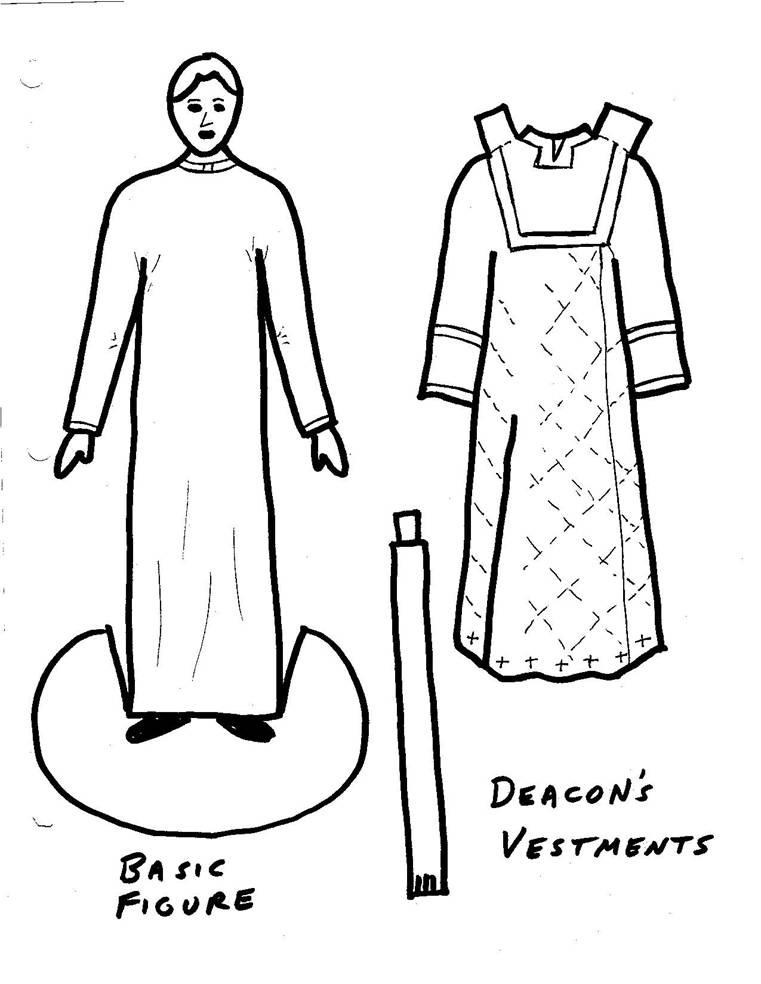
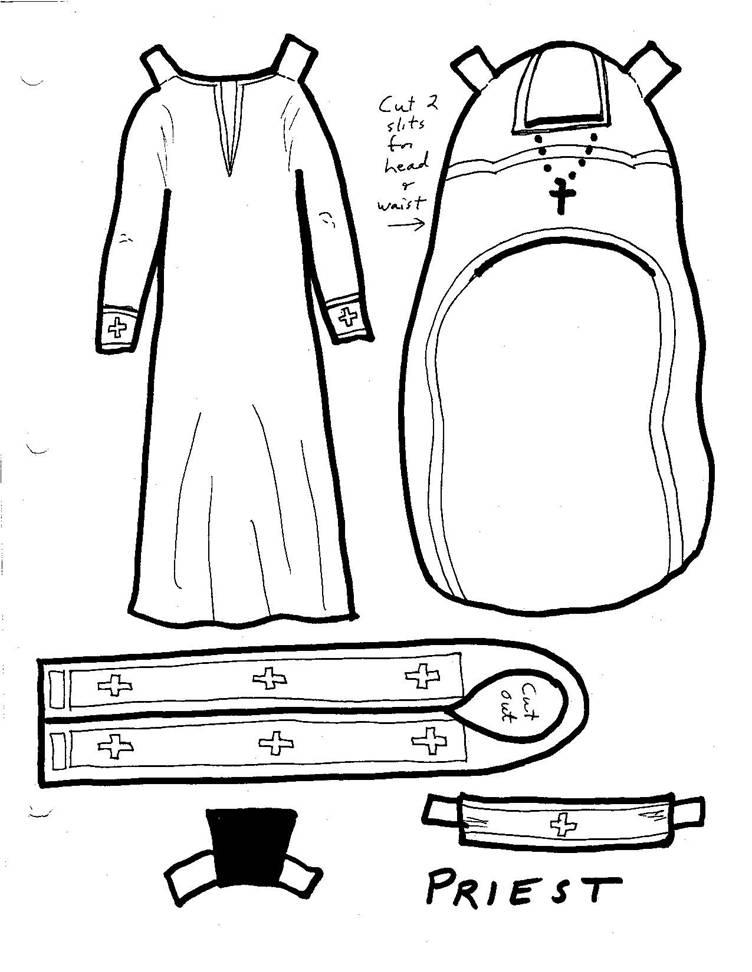
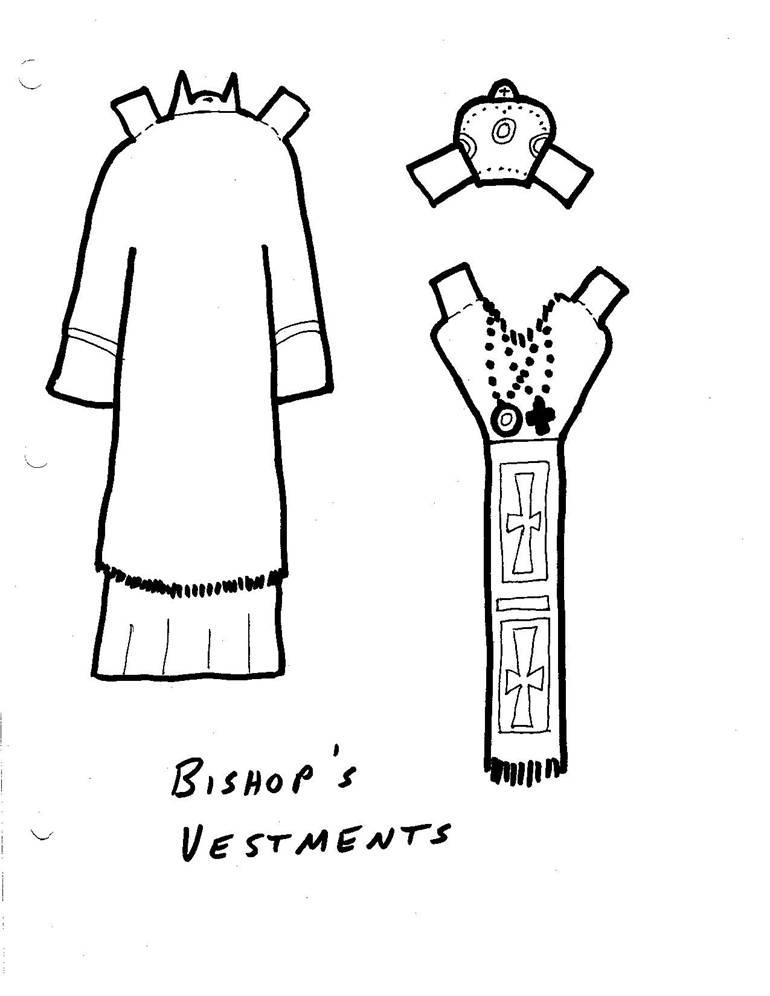
Ascension
ASCENSION
Objectives:
- Students should understand the icon and its characters and be able to tell the story of the Ascension.
- Students should know that Ascension occurs 40 days after Pascha.
Possible Lesson Plan:
- Open with prayer.
- Review the icon, seeing how much they already know: Christ is the central figure, clothed in white (Why?) and bestowing a blessing on the world with hands outstretched, the Theotokos just below Christ, the disciples (including whom as a replacement for Judas? Matthias) Are they in the city or the countryside?
- Scripture readings:
Gospel: Luke 24: 36-end, read also Matthew 28:16-end
Epistle: Acts 1: 1-12
Old Testament: Isaiah 2:2-3, Isaiah 62: 10-63:3, Zechariah 14:1,4,8-11
- Songs of the Feast;
Troparion: Thou has ascended in glory, O Christ our God, and gladdened Thy disciples with the promise of the Holy Spirit, having become confident of the blessing. Verily, Thou art the Son of God, the Deliverer of the world!
Kontakion: When Thou didst fulfill thy dispensation for our sakes, uniting the terrestrials with the celestials, Thou didst ascend in glory, O Christ our God, inseparable in space, but constant without separation, and crying unto thy beloved, I am with you, and no one shall be against you.
- Discussion questions:
What were Jesus’s promises on Ascension? (there are 3: to send the Spirit, to be with them always, and to return in glory) What did He tell his disciples to do? Where did the Ascension occur? (on the Mount of Olives, near Bethany) In what way is the Ascension the crowning of the Paschal mystery? Which of the apostles pictured in the icon could not possibly have been there? (St. Paul) Why? (He was converted on the road to Damascus, much later.) Why is he pictured in the icon? (He was a witness to the resurrection just like the others since Jesus Himself appeared to Saul.)
Where does Jesus sit now? (at the right hand of the Father) Where is that? (the point here is that it is not an earthly place; thus the angels asked the bewildered disciples why they were looking at the sky) A cloud came and removed Jesus from the sight of His disciples; where else do we see a cloud with a divine appearance? (Red Sea, Mt. Sinai and the 10 Commandments, Mary at the Annunciation, Transfiguration) What did the apostles do between Ascension and Pentecost? (wait!!!) Compare and contrast Ascension and Transfiguration.
- Make a “GoYe Globe” ornament: Take the pattern on the next page. Attach hanging string after coloring and assembling with tape. Run string all the way through the globe and out the bottom, attaching a “Go Ye” sign at the bottom.
- Make a felt banner as before. Here are a few ideas:
8. Close with prayer.
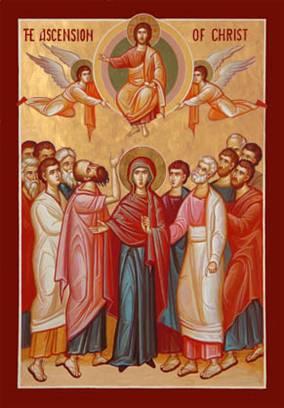
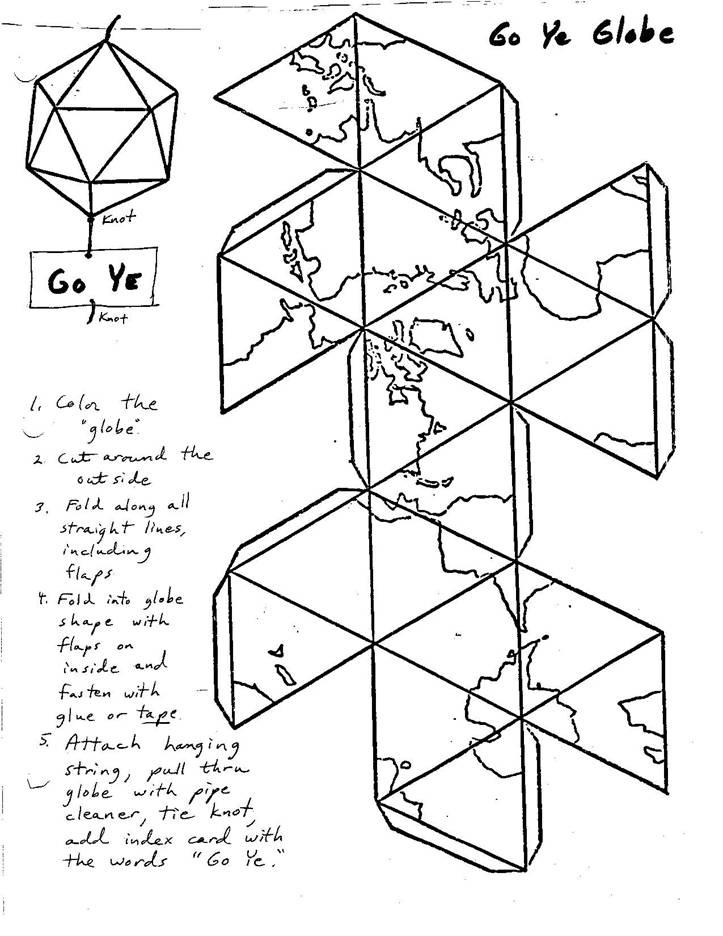
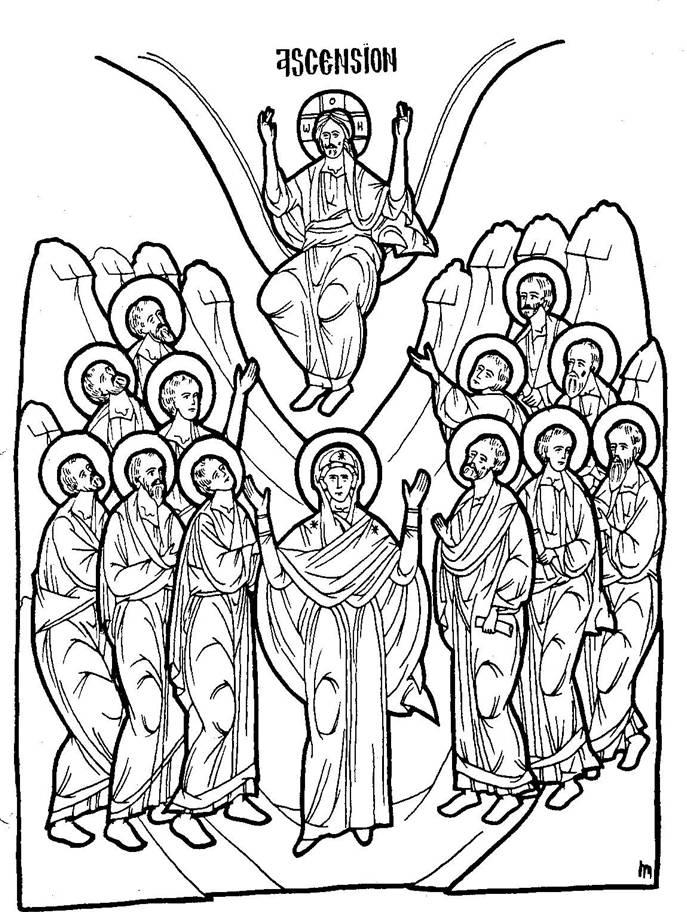
Pentecost
PENTECOST
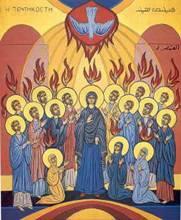 Objectives:
Objectives:
- Students should understand the icon and its characters.
- Students should know that “Pentecost” means “fiftieth” and is celebrated on the fiftieth day after Pascha.
- Students should understand why Pentecost is called the birthday of the Church.
Possible Lesson Plan:
- Open with prayer.
- Review the icon; what do they already understand? The disciples are gathered in the upper room (What last happened there? the Last Supper), in some icons each has a flame above his head (Why?), the book of the Gospels sits in the center, by which the Holy Spirit has revealed the spiritual presence of Christ to the world, the little crowned figure seated in the middle is the world! There is an empty place at the top of the horseshoe formed by the apostles; who will fill this place at the Second Coming? The icon shows only 12 apostles; how many believers were actually there?
- Scripture readings:
Gospel: John 7:37-52, 8:12. Read also John 14:16-17, 15:26-27, 16:7-13.
Epistle: Acts 1:1-12
Old Testament: Numbers 11:16-17, 24-29, Joel 2:23-end, Ezekiel 36: 24-28
- Songs of the Feast:
Troparion: Blessed art Thou, O Christ our God, Who hast revealed the fishermen as most wise, by sending down upon them the Holy Spirit; through them thou didst draw the world into thy net, O Lover of man, glory to Thee.
Kontakion: When the high One descended, confusing tongues, he divided the nations. And when he distributed the fiery tongues he called all to one unity. Wherefore, in unison we glorify the most Holy Spirit.
O Heavenly King: O heavenly King, the Comforter, the Spirit of Truth, Who art everywhere and fillest all things, Treasury of blessings and Giver of light, Come and abide with us, and cleanse us from every impurity, and save, O good One, our souls.
- Discussion questions:
What happened at Pentecost? Did the apostles obey Jesus’s commandment to “Go forth and preach”? Who descended? Who is the Holy Spirit? In what sacrament do we receive the Holy Spirit? (Chrismation) How does the Spirit, God Himself, dwell in us? How can we tell He does – did we see tongues of fire? This is a great mystery, as are all the sacraments. Why is He called “Comforter”? In our prayer, “O heavenly King” we ask the Holy Spirit to come, why? (Jesus commanded us in Luke 11: 9-13.)
Why do we decorate the Church in green? (as a sign of the life the Holy Spirit brings us) In what way is Pentecost the birthday of the church? (the first Christians were baptized by the apostles)
What is speaking in tongues? (speaking in other languages as the apostles did at Pentecost) How is this different from the tower of Babel? (Here we see harmony and subjection to God’s action; there we see confusion and disunity from an attempt by man to reach God by his own means, resulting in hatred, racism, and war.)
Why were there so many Jews in Jerusalem from all over the world at that time (50 days after Passover) anyway? (They are also celebrating Pentecost, the giving of the Law 50 days after Passover on Mt. Sinai; it is also the “Feast of Weeks” and the thanksgiving for the harvest) So the Old Covenant Pentecost, the Law, is supplanted by the New Covenant Pentecost, the Spirit (See Jeremiah 31:31-34). But even in the Old Testament readings, we see the Holy Spirit: in Numbers (How? Moses distributes the gifts of the Holy Spirit to the 70 elders), in Ezekiel (a new spirit inside our hearts).
How do we end the Pentecost celebration? (with kneeling vespers, we again kneel in a spirit of penitence, which we will keep until the next Paschal season) What does it mean to say, Christ saves but the Holy Spirit sanctifies? What does it mean to be a Temple of the Holy Spirit (I Cor. 6:19)? How can we desecrate that Temple? How can we renew the gift of the Holy Spirit in our daily lives? How might we ask the Holy Spirit to guide and fill us?
- Make a “We Are Filled with the Holy Spirit” mural: Take a wall-sized piece of paper. Draw the figures from the icon hugely on it, complete with flames of fire. Cut out each face. Have the students stand behind the figures with their faces showing through. We are all called to be saints, not just those who lived in the first century.
- Alternate craft idea: Gifts of the Spirit mobile: Cut out large dove of white cardstock and write on it “Gifts of the Spirit”; punch a hole in the top and tie hanging string. Cut 7 small flames of yellow cardstock. Cut the “donut” below, as large as you want, from yellow or orange cardstock and write along it Acts 2: 2-3. Now cut it along the solid lines – a miracle, your hanging part is ready. Write one of the gifts of the spirit on each flame and tape, glue, or staple to dangler and staple dangler to dove.
- Make a felt banner as before. Here are a few ideas:
8. Close with prayer.
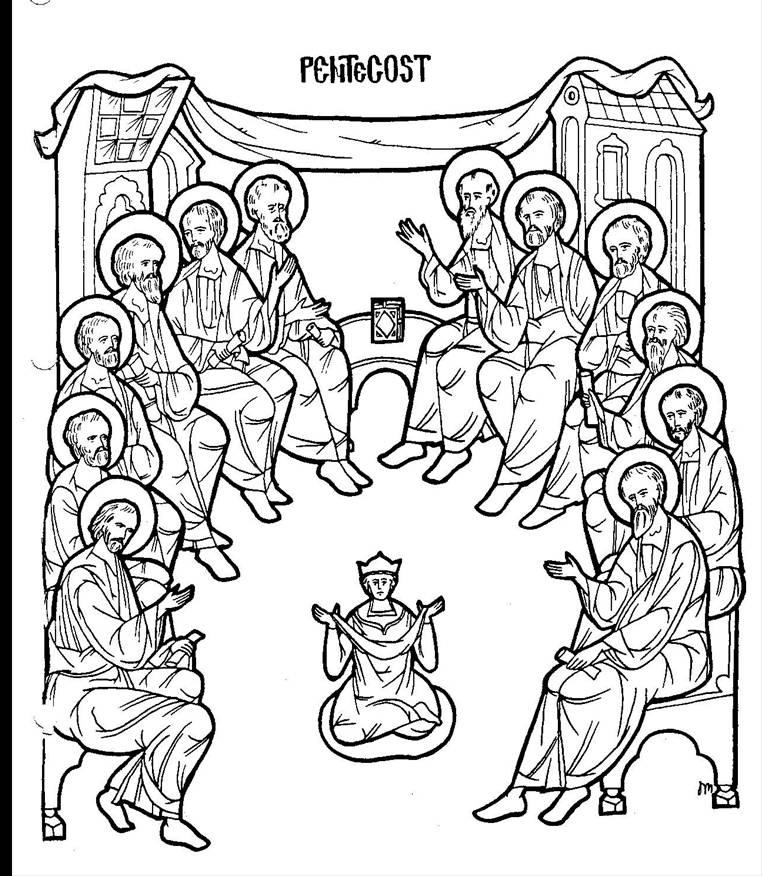
Holy Unction
HOLY UNCTION
Objectives:
- Students should know the Scriptural basis for holy unction.
- Students should know the outline of the service and its meaning.
Possible Lesson Plan:
- Open with prayer.
- Scriptural basis: James 5:14-15, Luke 4:18, Matthew 10:5-9, Matthew 4:23, Acts 9:34, I Corinthians 12:9, John 14:12, Mark 2:1-12. Review some of the miracles of Christ: Can each student remember or find one in his Bible? Does God care about human suffering and illness?
- The order of the service:
|
Action |
Meaning |
|
1. Confession. |
The sick person must be healed in soul as well as in body. (See the story of the paralytic above.) |
|
2. Introductory prayers and psalms. |
We confess our sinfulness and ask God to create a new spirit within us. |
|
3. Canon. |
We ask God to have mercy on us, drive away all evil powers, and grant us healing so we may bless Him forever. |
|
4. Troparia to the Saints. |
We ask the saints, especially those who have suffered themselves as martyrs, and Mary to intercede for us. |
|
5. Epistle and Gospel lessons. |
Seven priests, seven epistles, and seven gospels – after each one the priest anoints the sick person with Holy Oil. |
|
6. Prayers of anointing. |
As the person is anointed, the priest reads a prayer asking for remission of the person’s sins and healing of his soul and body. |
- Discussion questions:
Can Jesus really heal the sick? Are there miracles today? Didn’t 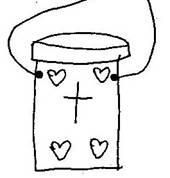 Jesus have to touch the person to heal him? (No, remember the Roman centurion’s servant) Aren’t miracles really superstition? How does the sacrament of Holy Unction differ from say a rain dance by the pagans? Don’t we have doctors now we can go to if we are sick? Why doesn’t Jesus heal everyone? Why do we get sick at all? Aren’t we all going to die anyway? Should we only call for Holy Unction when we are dying? (no) In what other ways can we as Christians serve those who are ill, especially those who are chronically ill?
Jesus have to touch the person to heal him? (No, remember the Roman centurion’s servant) Aren’t miracles really superstition? How does the sacrament of Holy Unction differ from say a rain dance by the pagans? Don’t we have doctors now we can go to if we are sick? Why doesn’t Jesus heal everyone? Why do we get sick at all? Aren’t we all going to die anyway? Should we only call for Holy Unction when we are dying? (no) In what other ways can we as Christians serve those who are ill, especially those who are chronically ill?
- Make a “First Aid Kit” necklace: Begin with an empty pill bottle or film container. Fill with some items a child will recognize – band-aids, cotton ball, Alcohol prep – but be sure to include the phone number of the priest to remind them to call for prayer!
After filling, paint the container (or cover with contact paper), poke a hole through each side of the top just below the lid, and attach a string for wearing.
Alternate craft idea: Make a Healing Prayerbook – Print the front and back on cardstock or mount on construction paper and copy the pages and cut out. Children can write in the names of people they want to pray for. They can decorate with stickers. To bind simply twist a pipe cleaner around the top or use a staple or a brad.
6. Close with prayer.
Requiem
REQUIEM
Objectives:
- Students should know the meaning of death in a Christian context.
2. Students should understand the Orthodox rituals surrounding death.
Possible Lesson Plan:
- Open with prayer.
2. Scriptural basis: John 11:1-46.
3. Order of the service: This service is quite brief; in the Russian tradition it is
called a panikhida. It opens with the Trisagion prayers, the Lord’s prayer, psalms and litanies for the deceased. The family hold candles, reminding them of the light of the resurrection. The priest then prays for rest for the soul of the departed, exclaiming that Jesus is the resurrection and the life. There follow hymns to God and to Mary, another litany and canon. In the end all sing “Memory Eternal”.
- Songs of the service: “Memory Eternal”; that’s all the words! Sing it now.
- Discussion questions:
What is the meaning of death? Why does God allow death? How did death enter the world? Whose victory is death? How does the world around us explain death? If death is the end of everything, how would you live? How do other religions view death? In what way would say that our entire spiritual life is a preparation for death? Are you afraid of dying? Why or why not? Does God care if we die? (Remember, “Jesus wept.”) Why is death always a tragedy? Has anyone ever escaped death? Did Mary die? How do we know we have victory over death? (the resurrection) What happens after death? What is the meaning of heaven and hell? What is the Last Judgment?
St. John of Kronstadt states: We say that our dead have “fallen asleep” or “passed away.” What does this mean? This means that for the true Christian there is no death. Death was conquered by Christ on the cross. But there is a translation, i.e, a rearrangement of his condition, i.e. his soul is in another place, in another age, in another world beyond the grave, eternal, without end, that is what is meant by “falling asleep”. It is as if it were a temporary dream after which, by the voice of the Lord and the fearful yet wonderful trumpet of the Archangel, all the dead shall live and come forth each to his place: either to the resurrection of life or to the resurrection of condemnation (John 5:29). This is what the Christian means by translation. We should be ready for this translation, for the day of the general resurrection and judgment, for this indescribable world event, recorded in the Holy Scriptures.
- This lesson comes near the date of the secular holiday, “Memorial Day.” Remind the students of the real meaning of this Day of Memory.
“
- Make koliva (We’ll make this together after class.):
The day before class, take 1 pound of wheat berries and soak them in water in a large pot. Then drain them and boil for 4 hours in fresh water. Drain again and spread on a large towel; bring to class wrapped in the towel. Empty wheat berries into a mixing bowl. Have the students add:
½ cup confectioner’s sugar
1 tsp cinnamon
2 cups raisins
1 cup chopped walnuts
Pour onto serving tray and make a small hill. Cover with thick layer of confectioner’s sugar and decorate with a candle in the center, crosses of silver candies, and a border of candied almonds.
- Make a wreath of red, white, and blue flowers to place at a local cemetery with an armed forces section. Travel as a class to place the wreath.
- Close with prayer. Have each student make a list of any deceased members of his family. Pray for these and for the soldiers who have died in the armed forces in front of your icon. Sing “Memory Eternal” together and eat the koliva.
Transfiguration
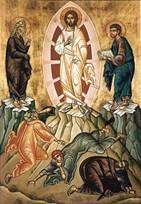 TRANSFIGURATION
TRANSFIGURATION
Objectives:
- Students should understand the icon, its characters and significance.
- Students should know that the feast is celebrated on August 6.
- Why are fruits blessed on this day?
Possible Lesson Plan:
- Open with prayer.
- The icon: See how much the students already know? Christ is the central figure, clothed in white and surrounded by an aureole (elongated halo). Why? Elijah and Moses flank Him; Moses is identified because he’s carrying what? Which disciples are below Christ and why have they fallen down? (Peter, James, and John) Where are they? (Mt. Tabor)
- Scripture readings;
Gospel: Matthew 17:1-9
Epistle: II Peter 1:10-19
Old Testament: Exodus 24: 12-end, 33: 11-end, 34:4-6, I Kings 19:3-16
- Songs of the Feast:
Troparion: When Thou, O Christ our God, wast transfigured on the mountain, Thou didst reveal Thy glory to Thy disciples in proportion as they could bear it. Let Thine everlasting Light also enlighten us sinners, through the intercessions of the Theotokos; O Thou Giver of Life, glory to Thee.
Kontakion: Thou wast transfigured on the mount, and thy disciples, in so far as they were able, beheld thy glory, O Christ our God: so that, when they should see thee crucified, they would remember that thy suffering was voluntary, and could declare to all the world that thou art truly the effulgent splendor of the Father.
- Discussion questions:
What preceded the Transfiguration? (Matthew 16:13-end: Jesus asked the disciples who He was? Peter answered. Jesus then told them about His suffering to come and told them that some of them would die before seeing Him in His glory, and a few days later…) In what way was Jesus preparing his disciples for his crucifixion? Why did the disciples forget about the Transfiguration and run away like cowards? Were the disciples chosen because they were such strong and perfect men? Or were they weak and fragile and quite ordinary, just like you and me? So the Troparion recalls their weakness in “as far as they could bear it”.
Who do Moses and Elijah represent? (Law and Prophets) In the Old Testament readings, what else do we see that Moses and Elijah have in common? (They both saw God’s presence and lived to tell! Moses saw only His back on Mt. Sinai and to Elijah on Mt. Horeb He was revealed as a still, small voice.) So the Law and the Prophets of the Old Testament are witness to the revelation of God Incarnate, the New Covenant. What was another time God, the Father, spoke out of heaven in witness of His Son? (Theophany)
In Transfiguration, we see Jesus as both God and man. Is he 2 people? Which council settled this issue? (Chalcedon) These are the questions of St. Ephraim: If Jesus were not human, who lay in the manger? If He were not God, whom did the angels glorify? If Jesus were not human, whom did Simeon take in his arms? If Jesus were not God, to whom did Simeon say, “Dismiss me in peace”? If Jesus were not human, whom did John baptize? If Jesus were not God, of whom did the Father speak? If Jesus were not human, who took Peter and James and John to the mount? If Jesus were not God, who spoke with Moses and Elijah?
Why doesn’t the Holy Spirit keep the same form on Mt. Tabor (What? luminous cloud) as at the Jordan (What? dove) or at Pentecost (What? tongues of fire)? It would be easier to recognize him if He would. Jesus always appears as a man since the Incarnation. But, the Spirit is not incarnate in the dove or the fire or the cloud; “He is everywhere and fills all things”.
Can we participate in the Transfiguration? What is the point of the reading from II Peter 2 today? We can become partakers of the divine nature – not that we in some sort of union become “one with God” (nirvana of the Hindus) but by grace we can become like God. The light emanating from Jesus, what does it represent? In what ways have we not been very much like God lately? How can we become more like God?
Why do we bless fruit on the feast of the Transfiguration? It is the peak of summer in our season and the time of ripeness of fruit. Can you think of a theological meaning for this? (maybe showing that the divine can transform all created things?)
- Make a diorama. Take a shoebox (or similar) for each student. Remove the lid. Cover the back with white paper, decorate like a mountain (as in the icon). You can use cotton balls for clouds. Put Easter grass on the bottom. Now add the figures, fashioned out of pipe cleaners. If you want, you can use wooden doll head beads for heads instead.
Way too hard? Just use a clear plastic food container, rectangular. Remove the lid. Stand on its side with bottom as the back. Color the background on the bottom with mountains, sky, and clouds. Put a bit of Easter grass on the "ground". Then cut out the figures from the icon with small rectangular bases under each. Glue or tape the figures in place.
- Make a felt banner as before. Here are a few ideas:
8. Close with prayer.
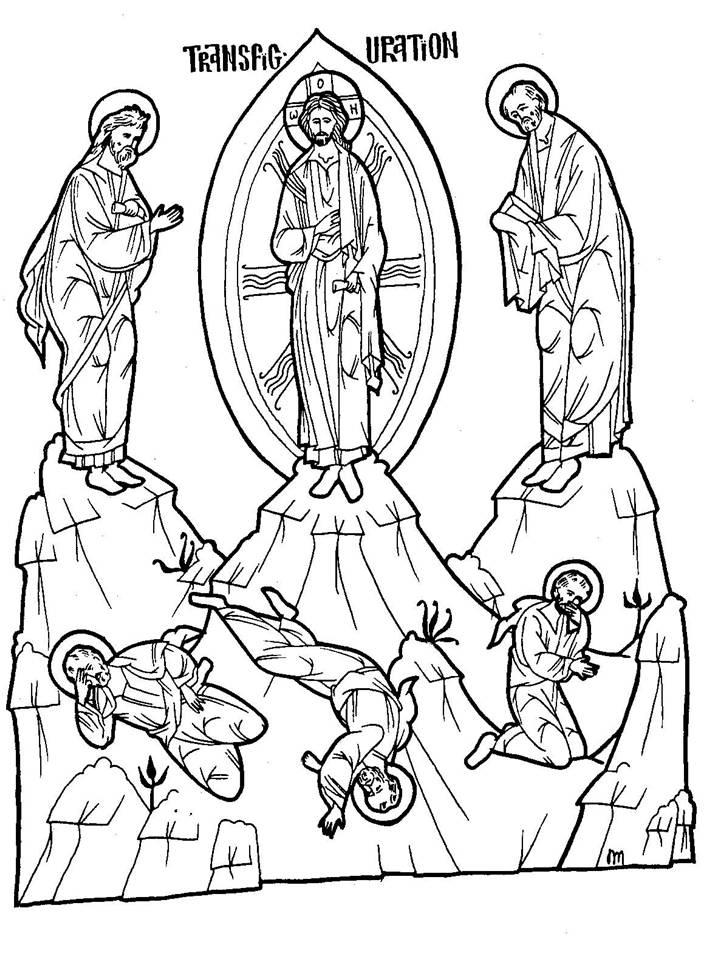

Dormition
DORMITION OF THE THEOTOKOS
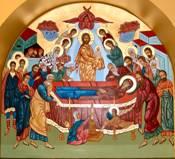 Objectives:
Objectives:
- Students should understand the icon, who’s in it and what it means.
- Students should know that we celebrate the Dormition on August 15, and that it is preceded by 2 weeks fast.
- Students should know why we celebrate it with flowers.
Possible Lesson Plan:
- Open with prayer.
- Look at the icon together and see how much the students already know: The Theotokos is on her funeral bier; Christ is standing behind her, ready to receive her soul (small child in His arm) into heaven. The apostles stand on either side of the bier; who’s on the front left? (Peter at the head of the bier) and who’s on the front right? (Paul at the foot of the bier) Who’s that man below the bier? He is Antoninus the Jew! What shape do Mary and Jesus make? (a cross!)
- Review the story itself:
After Pentecost, Mary stayed in Jerusalem, comforting the young Christian Church there. In her early fifties, she was near death. The apostles were scattered all over the world preaching the gospel. However, they all were miraculously returned to Jerusalem in time for her burial – all except Thomas. Remember Doubting Thomas? Thomas arrived late, and when the others took him to her tomb in the Garden of Gethsemane, the tomb was empty. Mary had been taken to heaven!
Antoninus the Jew is depicted on the icon. He was a fanatical Jew, who tried to overturn the coffin of Mary to dishonor her body. An archangel was sent and cut off his hands to stop him from this disgraceful act. Later in his life, Antoninus became a Christian and was healed.
- Scripture readings:
Gospel: Luke 10:38-end, 11: 27-28
Epistle: Philippians 2:5-11
Old Testament: Genesis 28:11-17, Ezekiel 43: 27-44:14, Proverbs 9:1-11
- Songs of the Feast:
Troparion: When thou didst give birth, O Theotokos, thou didst preserve thy virginity; and in thy falling-asleep thou has not forsaken the world; for thou wast translated to Life since thou art the Mother of Life. Wherefore, by thine intercessions, deliver our souls from death.
Kontakion: Truly, the Theotokos, who is ever watchful in intercessions, who is never rejected, neither tomb nor death could control. But being the Mother of Life, He Who dwelt in her ever-virgin womb did translate her to life.
- Discussion questions;
Is the feast of the Dormition chronicled in Scripture? Does this mean that this is only legend? What is the purpose and importance of Holy Tradition? Is the Dormition the same as the Immaculate Conception, as taught by the Roman Catholic Church? If Mary were not bodily raised, how come we have no relics of her body?
What is the meaning in the Troparion of “you did not forsake the world”? What is Mary doing now in heaven? (interceding for us) Has Mary ever appeared on earth since her Dormition? One instance is celebrated in the feast of the Protection of the Virgin on October 1, when Mary appeared in Constantinople, on the steps of a church praying and crying, and the imminent barbarian invasion miraculously disappeared. What are miraculous icons? (icons that weep or exude a fragrant odor or produce healing oil) They are almost always icons of the Virgin Mary, showing her continuing love as a mother for all of us.
Why do we celebrate this feast with flowers? When the apostles went to the tomb and found it empty, the tomb was filled with the overwhelming fragrance of flowers. Flowers are brought to church and blessed; they can then be taken home to fill the home with their fragrance.
7. Learning Game: We celebrate 5 major feasts involving the Theotokos. Learn them with a pose for each:
Nativity of Mary: Rocking baby in arms
Presentation of Mary in the Temple: One leg raised as if climbing stairs
Annunciation: Angel wings arms flapping
Nativity of Jesus: Stick out straight arms and legs to make star shape (like jumping jack)
Dormition: Sleeping hands at face
Once poses are reviewed, when leader says “Go”, each child picks a pose and freezes. Leader spins spinner and the children with that pose are “out”. Continue until only one child remains. Children cannot use the same pose twice in a row.
FEASTS OF MARY SPINNER
Use large paperclip on a brad for the spinner itself. Print on cardstock, or on regular paper and glue to paper plate.
8. Make tissue paper flowers. Daylilies or white lilies would be especially nice. With this age group, you should be able to make some nice flowers. Have tissue paper of desired colors, very thin wire, green pipe cleaners, and green floral tape. Cut 8 of each petal for each flower. Lay one petal down, put a thin piece of wire in the center, glue another petal over it; this is a finished petal. Make 4 petals for each flower. Then shape together, wrapping the bottoms with wire to hold together. Line up a stem pipe cleaner with wired bottom of flower and wrap with floral tape, covering the wire and running part-way down the pipe cleaner.
Lots of other flower ideas:
9. Make a felt banner as before. Here are a few ideas:
10. Close with prayer.
